2021 Annual Report for: Tortricidae / Tortricinae
For species seen in 2021 that had less than or equal to 100 records, full details are included; for more common species, the earliest, latest and highest count by vice-county are shown. The narrative for each species is taken from the main Hantsmoths website, and it is possible that some information on abundance and occurrence can get out of date, as it is impossible to keep up with all changes; however it should give a good introduction to each species. The tables in each species account summarise the previous status, and that for the current year.
For the maps, all records prior to 2021 are shown by a blue dot (the larger the dot, the more recent), with the current year's records shown in red. As previous records are superimposed on any report for 2021, new sites have greater emphasis (i.e. will show as 'more red').
In the species accounts, an asterisk next to a location indicates a new 10km square record; earliest ever dates are highlighted in orange, and latest ever in red. Initials in the species accounts refer to the recorders listed here. Please get in touch if you identify any omissions or errors, in particular if you have records that have yet to be submitted. Details of how to submit records can be found here.
49.004 [B&F: 1010] Red-barred Tortrix Ditula angustiorana (Haworth, 1811) - Common
Common in woodland, parks and gardens throughout much of the British Isles, less numerous in the north. In Hampshire and on the Isle of Wight common to very common. Wingspan 13-18 mm. The dark coloration of the fore- and hindwings, and the strongly pectinate antennae, are characteristic of the male; in the female the forewing is attenuated and the markings contrast with the greyish white ground colour [Bradley]. The larva is polyphagous on many plants, including yew and rhododendron - species that otherwise have few predators. It sometimes does superficial damage to ripening fruits in orchards.
Records prior to 2021
| Vice County | #Records | #Individuals | First Record | Last Record |
|---|---|---|---|---|
| 10 | 223 | 343 | 1893 | 2020 |
| 11 | 1842 | 2486 | 1958 | 2020 |
| 12 | 815 | 1665 | 1976 | 2020 |
2021 records
| Vice County | #Records | #Individuals | Max Quantity |
|---|---|---|---|
| 10 | 30 | 52 | 5 |
| 11 | 146 | 236 | 8 |
| 12 | 84 | 168 | 19 |
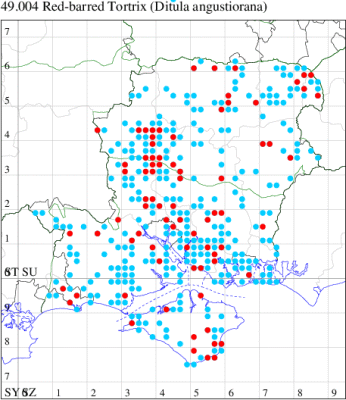
Records by year
Records by week (adult)
Records by week (larval)
Record Summary
VC10: Earliest: Bonchurch, 05 Jun, 1 (JHa) Latest: Shanklin, 04 Aug, 2 (IOut) Max count: Haseley Manor, 19 Jul, 5 (IOut)
VC11: Earliest: Horndean, 19 Apr, 1 (PHog) Latest: Totton, 07 Sep, 1 (LHan) Max count: Marchwood, 15 Jul, 8 (CTha)
VC12: Earliest: Farnborough, 14 Jun, 1 (MThop) Latest: Blackwater, 14 Aug, 2 (BDal) Max count: Yateley Common, 08 Jul, 19 (BDal)
49.005 [B&F: 1006] Epagoge grotiana (Fabricius, 1781) - Common
Common in woodland and on sand-dunes throughout the British Isles. In Hampshire widespread in woodland, probably under-recorded on the Isle of Wight. Wingspan 13-17 mm. The bright ochreous-yellow ground colour of the forewing and the ferruginous-brown markings are characteristic. Flies at dawn and dusk. Larva feeds on Oak, Hawthorn and Bramble, living within a spun or rolled leaf.
Records prior to 2021
| Vice County | #Records | #Individuals | First Record | Last Record |
|---|---|---|---|---|
| 10 | 26 | 85 | 1893 | 2020 |
| 11 | 332 | 518 | 1973 | 2020 |
| 12 | 149 | 319 | 1976 | 2020 |
2021 records
| Vice County | #Records | #Individuals | Max Quantity |
|---|---|---|---|
| 10 | 8 | 17 | 5 |
| 11 | 18 | 23 | 4 |
| 12 | 12 | 21 | 4 |
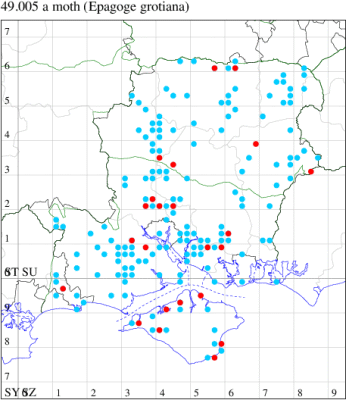
Records by year
Records by week (adult)
Records by week (larval)
Record Details
VC10: Freshwater, one, 27 Jun; Mottistone Down, three, 07 Jul; Newtown NNR, two, 02 Jul; Walter's Copse, Newtown, one, 04 Jul (PBar); Parkhurst Forest, two, 13 Jul (TJN, IMer, LFom); Wheelers Bay, one, 03 Jun (ABut); Shanklin Upper Chine, two, 18 Jul; Osborne Valley Walk, five, 22 Jul (IOut);
VC11: Marchwood, one, 18 May (TDCh); Woodlands, NF, present, 19 Jul (RBW); Romsey, one, 09 Jul; one, 13 Jul; one, 15 Jul (MBak); one, 02 Jul (NRJ); Valley Park, Chandlers Ford, one, 14 Jul; one, 19 Jul (KArb); Allbrook, one, 19 Jul (SIng); Botley Wood, one, 30 Jul (RJD, DWal, KJW det. RJD); Wickham, four, to light, 09 Jul (KCok, RJD, MLO, ADT, KJW det. RJD); one, 08 Jul; one, 18 Jul; three, 19 Jul; one, 20 Jul; two, 22 Jul (JRDS); West Walk, one, 23 Jul (RJD, MLO, ADT, DWal, KJW); Hurn, one, 30 Jun (MJef);
VC12: Little Somborne, two, 12 Jul; Crawley, one, 17 Jul; one, 13 Jul; one, 13 Jul (GCE); Axmansford, three, 17 Jul (ACB); Great Haughurst Copse, Axmansford, four, 08 Jul (ACB, GJD); one, 06 Aug (ACB); Beech, one, 28 Jul (NDP); Pamber Forest, one, 15 Jul; one, 16 Jul (GJD); Liphook, Hampshire, one, 20 Jul (RForr)
49.009 [B&F: 1007] Capua vulgana (Frölich, 1828) - Common
Common in woodland, downland and acid grassland throughout the British Isles. In Hampshire and on the Isle of Wight widely distributed but not particularly common. Wingspan 13-19 mm. The male may be distinguished by the paler basal area of the forewing and the pale buff head and labial palpi, the female somewhat resembles an obscurely marked Cnephasia but differs in having the forewing distinctly buff-coloured [Bradley]. Larva feeds on Hornbeam, Alder, Rowan, Raspberry and Bilberry, living within a spun or rolled leaf, and over-wintering as a pupa.
Records prior to 2021
| Vice County | #Records | #Individuals | First Record | Last Record |
|---|---|---|---|---|
| 10 | 9 | 31 | 1978 | 2016 |
| 11 | 115 | 153 | 1973 | 2020 |
| 12 | 39 | 55 | 1974 | 2020 |
2021 records
| Vice County | #Records | #Individuals | Max Quantity |
|---|---|---|---|
| 10 | 3 | 4 | 2 |
| 11 | 6 | 6 | 1 |
| 12 | 1 | 1 | 1 |
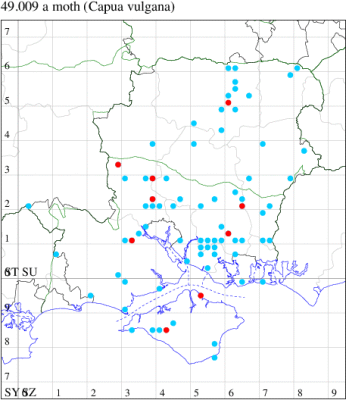
Records by year
Records by week (adult)
Records by week (larval)
Record Details
VC10: Brighstone Down East, two, gen det completed on one male 13 June, 09 Jun; one, 09 Jun; Osborne Valley Walk, one, 15 Jun (IOut);
VC11: Broughton Down, one, 12 Jun (MBot); Ashurst, one, 01 Jul (RFC); Romsey, one, 03 Jun (NRJ); Kings Somborne, one, 09 Jun (GCE); West Walk, one, male, 04 Jun; Old Winchester Hill, one, female, 11 Jun (RJD, MLO, DWal, KJW det. RJD);
VC12: Basingstoke, one, 07 Jun (JEH)
49.013 [B&F: 0977] Large Fruit-tree Tortrix Archips podana (Scopoli, 1763) - Common
Common in a wide range of habitats, including gardens, orchards, hedgerows and woodland, throughout England and Wales. Well distributed across much of Hampshire and on the Isle of Wight. Wingspan male 19-23 mm, female 20-28 mm. The male lacks the purple-brown ground colour of the forewing of A. oporana; the female is more similar to A. betulana but readily distinguished by the orange coloration in the apical half of the hindwing [Bradley]. Larva polyphagous on a wide variety of deciduous trees and shrubs, even occasionally on conifers, living within a spun or rolled leaf, and sometimes a pest on Apple trees.
Records prior to 2021
| Vice County | #Records | #Individuals | First Record | Last Record |
|---|---|---|---|---|
| 10 | 343 | 744 | 1856 | 2020 |
| 11 | 2059 | 2856 | 1964 | 2020 |
| 12 | 1035 | 2087 | 1971 | 2020 |
2021 records
| Vice County | #Records | #Individuals | Max Quantity |
|---|---|---|---|
| 10 | 48 | 91 | 6 |
| 11 | 68 | 92 | 6 |
| 12 | 50 | 94 | 11 |
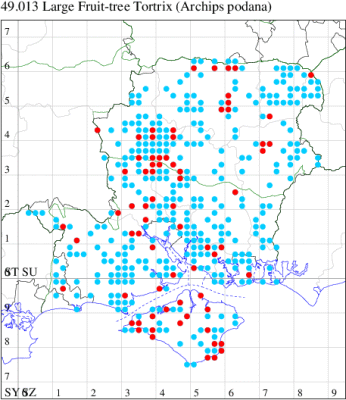
Records by year
Records by week (adult)
Records by week (larval)
Record Summary
VC10: Earliest: Totland, 24 Jun, 1 (RTer) Latest: Shanklin, 06 Oct, 1 (IOut) Max count: Shanklin, 18 Jul, 6 (IOut)
VC11: Earliest: Totton, 08 Jun, 1 (LHan) Latest: Winter Down Copse, Little Somborne, 07 Oct, 1 (GCE) Max count: Wickham, 09 Jul, 6 (KCok, RJD, MLO, ADT, KJW)
VC12: Earliest: Basingstoke, 09 Jun, 1 (GAH) Latest: South Warnborough, 07 Oct, 1 (DLee) Max count: Great Haughurst Copse, Axmansford, 08 Jul, 11 (ACB, GJD)
49.014 [B&F: 0979] Brown Oak Tortrix Archips crataegana (Hübner, [1799]) - Local
Local in woodland throughout much of England and Wales. In Hampshire and on the Isle of Wight scarce and barely annual in scattered localities. Wingspan male 19-22 mm, female 23-28 mm. Usually larger than Variegated Golden Tortrix A. xylosteana and differing in the broader forewing which in general appearance is browner and less variegated. The male is further separated by the median fascia which is obsolete on the costa; the female by the fuscous reticulation and the more prominent apex of the forewing [Bradley]. Larva feeds on deciduous trees and bushes, including Oak, Elm, Ash, Lime and Sallow, living within a spun or rolled leaf, and over-wintering as an egg
Records prior to 2021
| Vice County | #Records | #Individuals | First Record | Last Record |
|---|---|---|---|---|
| 10 | 26 | 47 | 1900 | 2020 |
| 11 | 34 | 32 | 1980 | 2020 |
| 12 | 34 | 80 | 1996 | 2020 |
2021 records
| Vice County | #Records | #Individuals | Max Quantity |
|---|---|---|---|
| 10 | 9 | 17 | 6 |
| 11 | 3 | 3 | 1 |
| 12 | 2 | 2 | 1 |
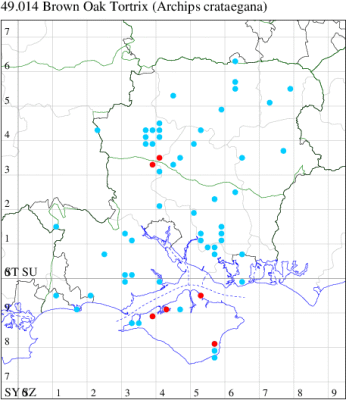
Records by year
Records by week (adult)
Records by week (larval)
Record Details
VC10: Cranmore, one, 13 Jun (CHic); Newtown NNR, one, 02 Jul (PBar); Shanklin, one, 07 Jul; one, 14 Jul; two, 17 Jul; six, 18 Jul; one, 19 Jul; two, 20 Jul; Osborne Valley Walk, two, 22 Jul (IOut);
VC11: Winter Down Copse, Little Somborne, one, 30 Jun; one, 30 Jun; one, 30 Jun (GCE);
VC12: Crawley, one, 12 Jul; one, 24 Jun (GCE)
49.015 [B&F: 0980] Variegated Golden Tortrix Archips xylosteana (Linnaeus, 1758) - Common
Common in woodland and gardens throughout the British Isles. In Hampshire and on the Isle of Wight widespread and fairly common in woodland throughout. Wingspan male 15-21 mm, female 16-24 mm. Most similar to A. crataegana, but differing in the more variegated appearance and smaller size [Bradley]. Larva feeds on various deciduous trees and bushes, including Oak, Elm, Lime, Hazel, Field Maple, Sycamore and Ash, living within a spun or rolled leaf, and over-wintering as an egg.
Records prior to 2021
| Vice County | #Records | #Individuals | First Record | Last Record |
|---|---|---|---|---|
| 10 | 156 | 639 | 1893 | 2020 |
| 11 | 1311 | 4532 | 1972 | 2020 |
| 12 | 616 | 3834 | 1971 | 2020 |
2021 records
| Vice County | #Records | #Individuals | Max Quantity |
|---|---|---|---|
| 10 | 19 | 51 | 16 |
| 11 | 63 | 157 | 25 |
| 12 | 67 | 414 | 121 |
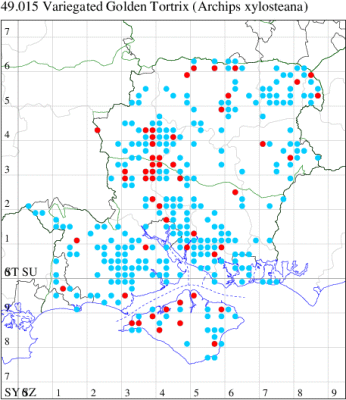
Records by year
Records by week (adult)
Records by week (larval)
Record Summary
VC10: Earliest: Cranmore, 16 Jun, 1 (CHic) Latest: Plaish, Carisbrooke, 22 Jul, 1 (KRyl) Max count: Newtown NNR, 02 Jul, 16 (PBar)
VC11: Earliest: Pennington, 15 Jun, 1 (RFC) Latest: Fareham, 10 Aug, 1 (MLO) Max count: Wickham, 09 Jul, 25 (KCok, RJD, MLO, ADT, KJW)
VC12: Earliest: Blackwater, 14 Jun, 1 (BDal) Latest: Goodworth Clatford, 21 Jul, 3 (GCE) Max count: Great Haughurst Copse, Axmansford, 08 Jul, 121 (ACB, GJD)
49.018 [B&F: 0983] Choristoneura hebenstreitella (Müller, 1764) - Local
Local in woodland throughout the British Isles, but not in northern Scotland. In Hampshire and on the Isle of Wight found in mature woodland and widely distributed in such habitat. Wingspan male 19-25 mm, female 24-30 mm. The large size and distinctive olive-brown markings are characteristic of this species [Bradley]. Larva feeds on various deciduous trees and shrubs, living within a spun or rolled leaf.
Records prior to 2021
| Vice County | #Records | #Individuals | First Record | Last Record |
|---|---|---|---|---|
| 10 | 25 | 109 | 1951 | 2017 |
| 11 | 71 | 77 | 1978 | 2020 |
| 12 | 58 | 101 | 1982 | 2020 |
2021 records
| Vice County | #Records | #Individuals | Max Quantity |
|---|---|---|---|
| 10 | 1 | 1 | 1 |
| 11 | 3 | 3 | 1 |
| 12 | 3 | 7 | 3 |
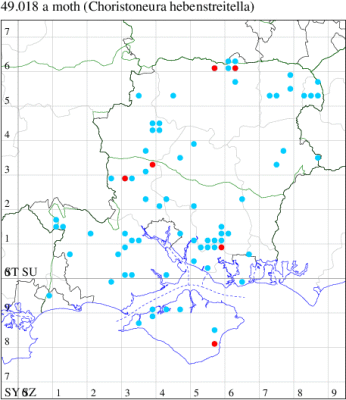
Records by year
Records by week (adult)
Records by week (larval)
Record Details
VC10: Shanklin, one, 14 Jul (IOut);
VC11: East Tytherley, one, 12 Jun; Winter Down Copse, Little Somborne, one, 30 Jun (GCE); Wickham, one, to light, 09 Jul (KCok, RJD, MLO, ADT, KJW);
VC12: Great Haughurst Copse, Axmansford, three, 08 Jul (ACB, GJD); Pamber Forest, one, 05 Jul (GJD)
49.020 [B&F: 0974] Argyrotaenia ljungiana (Thunberg, 1797) - Common
Common on heathland and moorland throughout much of the British Isles. In Hampshire found on heathland in the New Forest and north-east of the county. On the Isle of Wight, there has been only one recent record, at Freshwater in 1995. Wingspan 12-16 mm. The silver-white ground coloration of the forewing is characteristic of this species [Bradley]. Larva polyphagous on various herbaceous plants, including Bog-myrtle, Heather and Bilberry, living within a spun or rolled leaf, over-wintering as a pupa.
Records prior to 2021
| Vice County | #Records | #Individuals | First Record | Last Record |
|---|---|---|---|---|
| 10 | 2 | 1 | 1880 | 1995 |
| 11 | 96 | 349 | 1972 | 2020 |
| 12 | 34 | 32 | 1976 | 2018 |
2021 records
| Vice County | #Records | #Individuals | Max Quantity |
|---|---|---|---|
| 11 | 3 | 1 | 1 |
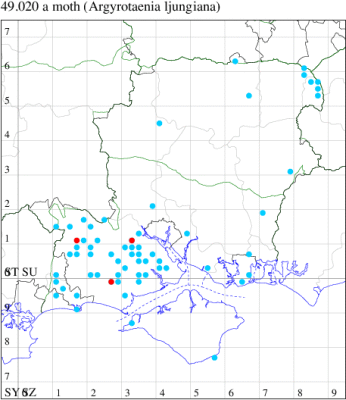
Records by year
Records by week (adult)
Records by week (larval)
Record Details
VC11: Ibsley Common, one, field observation, 29 Jul (MSP, AMD, RFox); Woodlands, NF, present, 19 Jul (RBW); Sway, present, 22 Jul (DMui)
49.021 [B&F: 0987] Ptycholomoides aeriferana (Herrich-Schäffer, 1851) - Common
Common in woodland throughout much of south-eastern England, where it was first recorded in 1951. In Hampshire first recorded in 1960 and now fairly widespread in occurrence across much of the county. First recorded from the Isle of Wight in 1982, there have been sporadic records since. Wingspan 17-21 mm. The yellowish ground colour of the forewing and the dark hindwing are characteristic of this species [Bradley]. Larva feeds on European Larch, living between needles spun together with silk.
Records prior to 2021
| Vice County | #Records | #Individuals | First Record | Last Record |
|---|---|---|---|---|
| 10 | 6 | 7 | 1982 | 2019 |
| 11 | 42 | 34 | 1971 | 2019 |
| 12 | 38 | 40 | 1980 | 2020 |
2021 records
| Vice County | #Records | #Individuals | Max Quantity |
|---|---|---|---|
| 10 | 1 | 1 | 1 |
| 11 | 2 | 2 | 1 |
| 12 | 1 | 3 | 3 |
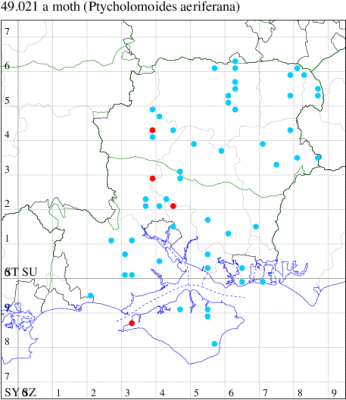
Records by year
Records by week (adult)
Records by week (larval)
Record Details
VC10: Freshwater, one, 31 May (DCoo);
VC11: Kings Somborne, one, 29 Jun (GCE); Allbrook, one, 18 Jul (SIng);
VC12: Harewood Forest, three, 21 Jul (GCE)
49.022 [B&F: 1000] Ptycholoma lecheana (Linnaeus, 1758) - Common
Common in woodland and orchards throughout much of the British Isles. In Hampshire and on the Isle of Wight widespread and fairly common in woodland throughout the county, but less common on the Island. Wingspan 16-22 mm. Distinguished by the generally dark coloration of the fore- and hindwings, the shining metallic edging of the median fascia and the metallic scaling in the apical area of the forewing [Bradley]. Larva feeds on deciduous trees and shrubs, living within a spun or rolled leaf, over-wintering in a cocoon.
Records prior to 2021
| Vice County | #Records | #Individuals | First Record | Last Record |
|---|---|---|---|---|
| 10 | 19 | 16 | 1969 | 2019 |
| 11 | 113 | 140 | 1972 | 2020 |
| 12 | 62 | 80 | 1976 | 2020 |
2021 records
| Vice County | #Records | #Individuals | Max Quantity |
|---|---|---|---|
| 10 | 3 | 3 | 1 |
| 11 | 5 | 5 | 2 |
| 12 | 8 | 16 | 9 |
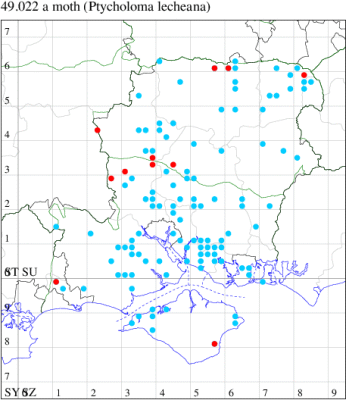
Records by year
Records by week (adult)
Records by week (larval)
Record Details
VC10: Shanklin, one, 08 Jun; one, 16 Jun; one, 23 Jun (IOut);
VC11: West Tytherley, one, 06 Jun (CWL det. SWoo); Broughton, one, 13 Jun; Winter Down Copse, Little Somborne, one, 02 Jun; two, 02 Jun (GCE); Merritown Heath, present, 10 Jun (DFoo);
VC12: Cholderton, one, 02 Jul (TJN, LFom, HEdm); Crawley, one, 05 Jun; one, 14 Jun; one, 14 Jun; one, 14 Jun (GCE); Great Haughurst Copse, Axmansford, one, 10 Jun (ACB); Pamber Forest, nine, 09 Jun (GJD); Yateley Common, larva, one, field observation, 27 May (BDal)
49.023 [B&F: 0971] Pandemis cinnamomeana (Treitschke, 1830) - Common
Common in woodland throughout much of England and Wales. In Hampshire widespread but rarely common, although frequent in Botley Wood. Probably under-recorded elsewhere, none more so than on the Isle of Wight, where it was not recorded until 2013. Wingspan 18-24 mm. Weakly marked specimens, especially those with drab coloration, may be confused with forms of Dark Fruit-tree Tortrix P. heparana, from which the male may be distinguished by the white head and the female by the presence of reddish ochreous suffusion in the apical area of the hindwing [Bradley]. Larva feeds on various deciduous trees and shrubs, living within a spun or rolled leaf.
Records prior to 2021
| Vice County | #Records | #Individuals | First Record | Last Record |
|---|---|---|---|---|
| 10 | 3 | 2 | 2013 | 2020 |
| 11 | 217 | 374 | 1971 | 2020 |
| 12 | 91 | 218 | 1994 | 2020 |
2021 records
| Vice County | #Records | #Individuals | Max Quantity |
|---|---|---|---|
| 11 | 16 | 37 | 5 |
| 12 | 15 | 36 | 21 |
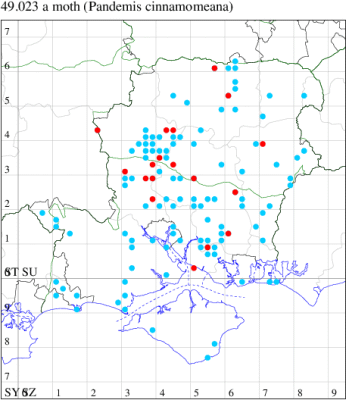
Records by year
Records by week (adult)
Records by week (larval)
Record Details
VC11: Kings Somborne, three, 15 Sep (GCE); Romsey, one, 24 Sep (NRJ); Kings Somborne, three, 15 Sep; one, 15 Sep; four, 15 Sep; Broughton, five, 06 Sep; Winter Down Copse, Little Somborne, one, 01 Sep; five, 01 Sep; two, 01 Sep (GCE); Brownwich cliffs, one, 16 Jul (MLO, RJD, KJW); Botley Wood, one, 13 Aug (MLO, ADT, DWal, KJW); one, 10 Sep; one, female, 15 Oct (RJD, MLO, DWal, KJW); West Walk, two, gen det, 24 Sep (RJD, MLO, ADT, KJW); West Meon, one, male, 02 Jul (RJD, MLO, ADT, DWal, KJW); five, 03 Sep (RJD, MLO, DWal, KJW);
VC12: Cholderton, 21, 10 Sep (TJN); Little Somborne, one, 03 Sep; Crawley, one, 07 Sep; one, 07 Sep; Barton Stacey, one, 29 Aug; one, 24 Sep; one, 02 Sep; two, 24 Sep; one, 24 Sep; one, 02 Sep (GCE); Morn Hill, Winchester, one, 11 Sep (CBey, DAS, PDF); Axmansford, one, 14 Sep (ACB); Basingstoke, one, 18 Sep (MJW); Alton, one, 18 Oct (DBO); one, 12 Sep (EFig)
49.024 [B&F: 0969] Chequered Fruit-tree Tortrix Pandemis corylana (Fabricius, 1794) - Common
Common in woodland and gardens throughout the British Isles. In Hampshire fairly common to common in suitable habitat, with rather few recent records from the Isle of Wight. Wingspan 18-24 mm. Similar to Barred Fruit-tree Tortrix P. cerasana, but distinguished by the characteristic reticulate forewing pattern and the more strongly oblique outer margin of the basal fasciae, which are parallel with the median fascia, and the paler apex of the hindwing [Bradley]. Larva polyphagous on a variety of deciduous trees and shrubs, living within a spun or rolled leaf.
Records prior to 2021
| Vice County | #Records | #Individuals | First Record | Last Record |
|---|---|---|---|---|
| 10 | 210 | 381 | 1856 | 2020 |
| 11 | 1507 | 2255 | 200 | 2020 |
| 12 | 670 | 1337 | 1971 | 2020 |
2021 records
| Vice County | #Records | #Individuals | Max Quantity |
|---|---|---|---|
| 10 | 24 | 50 | 7 |
| 11 | 103 | 171 | 6 |
| 12 | 56 | 81 | 8 |
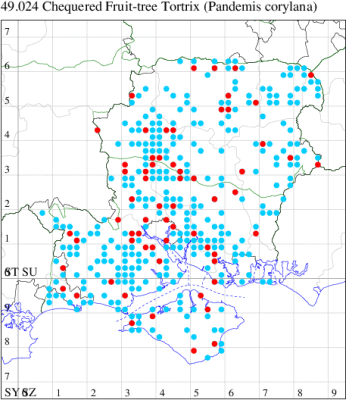
Records by year
Records by week (adult)
Records by week (larval)
Record Summary
VC10: Earliest: Freshwater, 16 Jul, 1 (DCoo) Latest: Freshwater, 18 Sep, 1 (DCoo) Max count: Shanklin, 08 Sep, 7 (IOut)
VC11: Earliest: Ashurst, 01 Jul, 1 (RFC) Latest: Fareham, 23 Sep, 1 (MLO) Max count: Winter Down Copse, Little Somborne, 11 Aug, 6 (GCE)
VC12: Earliest: Pamber Forest, 16 Jun, 2 (GJD) Latest: Morn Hill, Winchester, 11 Sep, 1 (CBey, DAS, PDF) Max count: Great Haughurst Copse, Axmansford, 20 Aug, 8 (ACB)
49.025 [B&F: 0970] Barred Fruit-tree Tortrix Pandemis cerasana (Hübner, 1786) - Common
Common in gardens, orchards and woodland throughout the British Isles. In Hampshire common and widespread, but rather infrequently recorded on the Isle of Wight in recent years. Wingspan 16-24 mm. Similar to Chequered Fruit-tree Tortrix P. corylana but differing in the smoother general appearance and the reduced reticulation, the usually strongly divergent margins of the basal and median fasciae, and the uniformly greyish brown hindwing [Bradley]. Larva is polyphagous on a variety of deciduous trees and shrubs, including fruit trees, living within a spun or rolled leaf, and over-wintering as an egg or small larva.
Records prior to 2021
| Vice County | #Records | #Individuals | First Record | Last Record |
|---|---|---|---|---|
| 10 | 397 | 1228 | 1900 | 2020 |
| 11 | 2027 | 3664 | 1969 | 2020 |
| 12 | 1000 | 2574 | 1971 | 2020 |
2021 records
| Vice County | #Records | #Individuals | Max Quantity |
|---|---|---|---|
| 10 | 42 | 109 | 14 |
| 11 | 81 | 105 | 6 |
| 12 | 44 | 88 | 10 |
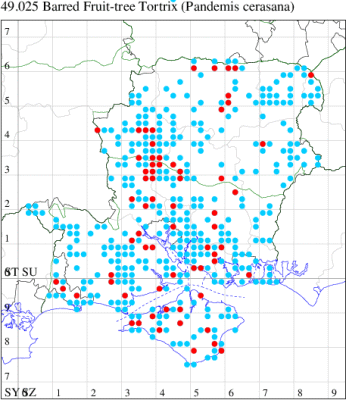
Records by year
Records by week (adult)
Records by week (larval)
Record Summary
VC10: Earliest: Osborne Valley Walk, 15 Jun, 4 (IOut) Latest: Totland, 04 Sep, 1 (RTer) Max count: Shanklin, 29 Jun, 14 (IOut)
VC11: Earliest: Romsey, 10 Jun, 1 (MBak) Latest: Brownwich cliffs, 17 Sep, 4 (RJD, MLO, DWal, KJW) Max count: West Meon, 02 Jul, 6 (RJD, MLO, ADT, DWal, KJW)
VC12: Earliest: Basingstoke, 04 Jun, 1 (JEH) Latest: Basingstoke, 23 Sep, 1 (MJW) Max count: Great Haughurst Copse, Axmansford, 08 Jul, 10 (ACB, GJD)
49.026 [B&F: 0972] Dark Fruit-tree Tortrix Pandemis heparana ([Denis & Schiffermüller], 1775) - Common
Common in oak woodland, orchards and gardens throughout the British Isles. Widespread and common in Hampshire and on the Isle of Wight. Wingspan 16-24 mm. Similar in general coloration to P. cinnamomeana but lacking the white scaling on the frons in the male and the reddish suffusion in the apical area of the hindwing in the female. The angular projection of the median fascia distinguishes P. heparana from P. cinnamomeana and from brownish forms of P. cerasana [Bradley]. Larva polyphagous on various trees and shrubs, including several species of fruit tree, on which it occasionally causes much damage, attacking flowers of crops such as apple, pear, plum and currant, otherwise often living within a spun or rolled leaf.
Records prior to 2021
| Vice County | #Records | #Individuals | First Record | Last Record |
|---|---|---|---|---|
| 10 | 180 | 234 | 1900 | 2020 |
| 11 | 1389 | 2522 | 1969 | 2020 |
| 12 | 771 | 1104 | 1976 | 2020 |
2021 records
| Vice County | #Records | #Individuals | Max Quantity |
|---|---|---|---|
| 10 | 22 | 30 | 3 |
| 11 | 27 | 37 | 5 |
| 12 | 17 | 22 | 3 |
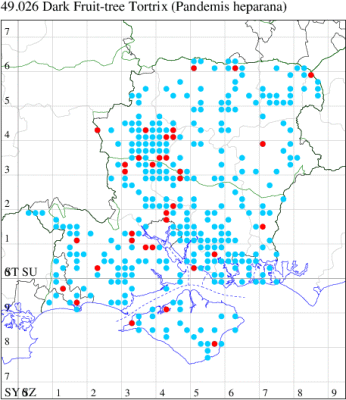
Records by year
Records by week (adult)
Records by week (larval)
Record Details
VC10: Totland, one, 27 Jul; one, 29 Jul; one, 30 Jul; one, 27 Aug (RTer); Freshwater, one, 15 Jun; one, 20 Jun; one, 02 Jul; one, 13 Jul; one, 16 Jul; one, 18 Jul; one, 22 Jul; two, 31 Jul; three, 04 Aug; three, 14 Aug; one, 17 Aug; three, 20 Aug; one, 23 Aug; one, 25 Aug; two, 27 Aug; Newtown NNR, one, field observation, 23 Aug (DCoo); Shanklin, one, 04 Aug; one, field observation, 11 Aug (IOut);
VC11: Furzehill, NF, one, 19 Aug (SLoa); Burley, NF, one, 21 Jul (NDP); Marchwood, one, 30 May (TDCh); one, 19 Jul; one, 30 Jul; one, 15 Sep (CTha); Woodlands, NF, present, 18 Jul (RBW); Totton, one, 11 Sep (CNB); Broughton, one, 25 Jul; one, 25 Jul; two, 25 Jul; Kings Somborne, one, 18 Jul; Winter Down Copse, Little Somborne, one, 11 Aug (GCE); Chandlers Ford, one, 25 Sep (AMur); Swaythling, Southampton, one, 20 Jul (MEdg); Allbrook, two, 22 Jul; one, 14 Sep; two, 21 Sep (SIng); Winchester, one, 25 Jul (THW); Brownwich cliffs, five, including one at sugar, 16 Jul (MLO, RJD, KJW); five, 17 Sep (RJD, MLO, DWal, KJW); Fareham, one, 21 Jul (MLO); Horndean, one, 26 Aug; one, 26 Aug (PHog det. PHog); Hurn, one, 16 Jul; one, 19 Jul (MJef); Stanpit Marsh LNR, one, 04 Jul (PAB);
VC12: Cholderton, two, 10 Sep (TJN); Goodworth Clatford, one, 08 Aug; two, 09 Aug (JMor); one, 21 Jul; Crawley, one, 13 Aug; one, 25 Aug (GCE); Harestock, one, 06 Aug (GRog); Barton Stacey, one, 24 Aug; one, 02 Sep; one, 01 Aug; two, 01 Aug; one, 01 Aug (GCE); Ecchinswell, one, 17 Jul (MJN); Pamber Forest, three, 16 Jul (GJD); Alton, one, 25 Jul (DBO); Blackwater, one, 15 Jul; one, 11 Aug (BDal)
49.028 [B&F: 0986] Syndemis musculana (Hübner, [1799]) - Common
Common in open woodland, mature hedgerows and high moorland throughout the British Isles. Widespread and common in Hampshire and on the Isle of Wight. Wingspan 15-22 mm. The greyish white or white ground colour and the contrasting median fascia are characteristic [Bradley]. Larva feeds on Bramble, Oak and Birch, living within a spun or rolled leaf, and over-wintering in a cocoon.
Records prior to 2021
| Vice County | #Records | #Individuals | First Record | Last Record |
|---|---|---|---|---|
| 10 | 124 | 192 | 1900 | 2020 |
| 11 | 669 | 865 | 1971 | 2020 |
| 12 | 342 | 479 | 1971 | 2020 |
2021 records
| Vice County | #Records | #Individuals | Max Quantity |
|---|---|---|---|
| 10 | 16 | 25 | 4 |
| 11 | 27 | 31 | 4 |
| 12 | 25 | 31 | 3 |
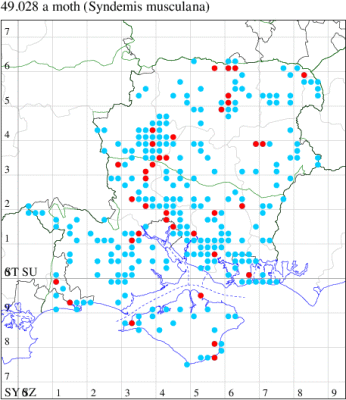
Records by year
Records by week (adult)
Records by week (larval)
Record Details
VC10: Totland, one, 29 May (RTer); Wheelers Bay, one, 14 Jun (ABut); Bonchurch, one, 22 May; one, 29 May; one, 31 May; two, 02 Jun; three, 05 Jun; two, 06 Jun; one, 10 Jun; two, 11 Jun; one, 15 Jun; two, 21 Jun (JHa); Shanklin, one, 27 May; one, 01 Jun; one, 02 Jun; Osborne Valley Walk, four, 01 Jun (IOut);
VC11: Broughton Down, one, 12 Jun (MBot); Woodlands, NF, present, 28 May (RBW); Totton, one, 08 May (LHan); Romsey, one, 31 May (MBak); Kings Somborne, one, 09 Jun; Ashley, one, 06 Jun; Winter Down Copse, Little Somborne, two, 02 Jun; two, 02 Jun; one, 02 Jun; one, 02 Jun; one, 02 Jun; one, 09 May; one, 02 Jun; three, 02 Jun; Crawley, one, 15 May (GCE); Stanbrige Earls, one, 03 Jun (JRM); Chandlers Ford, one, 03 Jun (AMur); Swaythling, Southampton, one, 28 May (MEdg); Southampton, one, 11 Jun (MGP); Fareham, four, 02 Jun (MLO); Botley, one, 11 May (SLB); Hilltop, The Hangers, one, 12 Jun (SIng det. DPH); Portsmouth, one, 09 Jun (IRT); Old Winchester Hill, one, 11 Jun (RJD, MLO, DWal, KJW); Merritown Heath, present, 28 May; present, 10 Jun (DFoo); Tuckton, Christchurch, one, 28 May (APar);
VC12: Chilbolton, one, 08 May (SLE det. GCE); Harewood Forest, two, 01 Jun; one, 01 Jun; one, 01 Jun; one, 01 Jun; Little Somborne, one, 28 May; one, 28 May; Crawley, one, 31 May; one, 31 May; one, 31 May; two, 31 May; Bullington, one, 10 Jun (GCE); Basingstoke, one, 01 Jun; one, 04 Jun (GAH); Axmansford, two, 02 Jun (ACB); Beech, one, 15 May (NDP); Basingstoke, one, 02 Jun; one, 10 Jun; one, 14 Jun; one, 23 Jun (MJW); one, 14 Jul (RHil); Pamber Forest, two, 09 Jun; three, 02 Jun (GJD); Alton, one, 01 Jun (DBO); Yateley Common, one, field observation, 26 May (BDal)
49.029 [B&F: 1002] Lozotaenia forsterana (Fabricius, 1781) - Common
Common in wooded gardens, hedgerows and woodland edges throughout the British Isles. In Hampshire widespread, but not very common; decidedly uncommon on the Isle of Wight. Wingspan 20-29 mm. Distinguished by its relatively large size and the reticulate greyish brown forewing with strong costal markings [Bradley]. Larva polyphagous on the foliage of Ivy and a number of deciduous and coniferous trees and shrubs, and various herbaceous plants, living within a spun or rolled leaf.
Records prior to 2021
| Vice County | #Records | #Individuals | First Record | Last Record |
|---|---|---|---|---|
| 10 | 128 | 160 | 1856 | 2020 |
| 11 | 1044 | 1521 | 1971 | 2020 |
| 12 | 259 | 323 | 1977 | 2020 |
2021 records
| Vice County | #Records | #Individuals | Max Quantity |
|---|---|---|---|
| 10 | 10 | 14 | 3 |
| 11 | 20 | 20 | 2 |
| 12 | 15 | 16 | 2 |
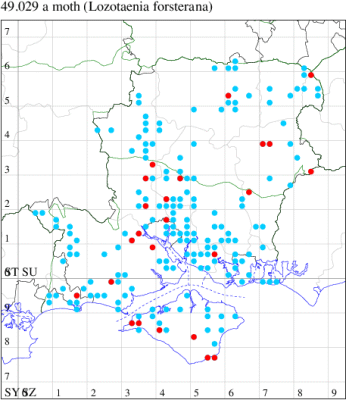
Records by year
Records by week (adult)
Records by week (larval)
Record Details
VC10: Totland, one, 22 Jun (RTer); Freshwater, one, 20 Jun; one, 26 Jun; one, field observation, 11 Jul (DCoo); one, 01 Jul; Mottistone Down, two, 07 Jul; Rew Down, Ventnor, three, 13 Jul (PBar); Bonchurch, one, 15 Jun; one, 14 Jul (JHa); Rookley, two, 25 Jun (JRB);
VC11: Marchwood, one, 29 Jun (CTha); Woodlands, NF, present, 13 Jun (RBW); Ashurst, one, 01 Jul (RFC); Totton, one, 06 Jun; one, 08 Jun; one, 09 Jun; two, 12 Jun; one, 30 Jun; one, 08 Jul (LHan); Romsey, one, 23 Jun; one, 25 Jun (MBak); Kings Somborne, one, 29 Jun; Crawley, one, 28 Jun (GCE); Swaythling, Southampton, one, 13 Jun (MEdg); Chandlers Ford, one, field observation, 23 Jun (AJB); Winchester, one, 04 Jul (THW); Fareham, one, 23 Jun (MLO); Burton, nr Christchurch, one, 23 Jun; one, 09 Jul (JStw); Sway, one, 03 Jul (DMui);
VC12: Old Basing, Basingstoke, one, 20 Jun (SVic); Basingstoke, one, 08 Jul (MJW); Alton, one, to lighted window, 22 Jul (BCA); one, to artificial light, 16 Jun; two, field observation, 20 Jun; one, 22 Jun; one, 28 Jun; one, to artificial light, 29 Jun; one, 18 Jul (DBO); one, 29 Jun; one, 30 Jun; one, 13 Jul; one, 16 Jul (NDP); Liphook, Hampshire, one, 19 Jul (RForr); Blackwater, one, 15 Jul (BDal)
49.030 [B&F: 0985] Carnation Tortrix Cacoecimorpha pronubana (Hübner, [1799]) - Common
Common throughout much of Britain and southern Ireland. An adventive species, naturalised through accidental introduction in garden plants in southern England in the early 20th Century. In Hampshire and on the Isle of Wight it is now widespread, mainly in suburban areas. Wingspan male 15-17 mm, female 18-22 mm. Often seen flying by day in the vicinity of its foodplants. The bright orange coloration of the hindwing is characteristic of this species [Bradley]. Larva feeds on Cultivated Privet, Sea Buckthorn, Evergreen Spindle and other deciduous trees and shrubs, living within a spun or rolled leaf.
Records prior to 2021
| Vice County | #Records | #Individuals | First Record | Last Record |
|---|---|---|---|---|
| 10 | 44 | 81 | 1950 | 2020 |
| 11 | 755 | 988 | 1971 | 2020 |
| 12 | 149 | 149 | 1995 | 2020 |
2021 records
| Vice County | #Records | #Individuals | Max Quantity |
|---|---|---|---|
| 10 | 1 | 1 | 1 |
| 11 | 33 | 39 | 3 |
| 12 | 3 | 3 | 1 |
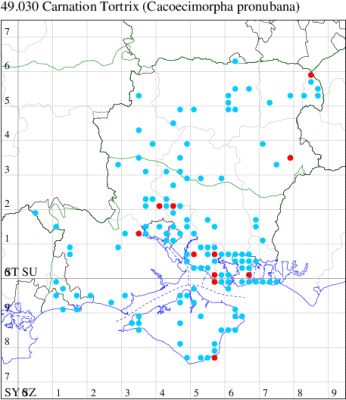
Records by year
Records by week (adult)
Records by week (larval)
Record Details
VC10: Wheelers Bay, one, 01 Sep (ABut);
VC11: Totton, one, field observation, 12 May; one, 02 Jun; one, 10 Jun; one, 11 Jun; one, field observation, 14 Jun; one, field observation, 17 Jun; three, 13 Jul; two, 15 Jul; one, 16 Jul; one, 12 Aug; one, 13 Aug; one, field observation, 14 Aug; one, 15 Aug; one, 27 Aug; one, 29 Aug; one, 03 Sep; one, 05 Sep; three, 06 Sep; one, 11 Sep; one, 17 Sep; one, 24 Sep (LHan); Barn Piece, Eastleigh, one, 26 May; Valley Park, Chandlers Ford, one, 22 Aug (KArb); Allbrook, one, 05 Sep (SIng); Locks Heath, one, field observation, collected as pupa from carnation, adult identified by Ian, 14 Aug (PPhi det. IRT); Lee-on-Solent, one, 14 Aug; one, 21 Aug; one, 02 Sep (IHrg); Fareham, one, 03 Aug; one, 22 Sep (MLO); Portsmouth, one, 14 Aug; one, 03 Sep (IRT); Browndown Coastal Ranges, two, 20 Aug (RJD, MLO, DWal, KJW det. RJD);
VC12: Whitehill, one, 05 Sep (ASto); Blackwater, one, field observation, 19 Jun; one, 03 Jul (BDal)
49.031 [B&F: 0989] Timothy Tortrix Zelotherses paleana (Hübner, 1793) - Common
Common on rough grassland and coastal sandhills throughout the British Isles, scarcer in the north. In Hampshire and on the Isle of Wight a local and uncommon species, but widely distributed, with no apparent population centre. Wingspan 17-24 mm. Whitish or greyish ochreous forms of this species can be confused with A. unitana, but may usually be distinguished by the darker cilia of the forewing in both sexes, and by the orange-yellow suffusion on the head and thoracic region and on the basal area of the forewing, especially in the male [Bradley]; see also Bilberry Tortrix A. viburnana. Larva feeds on various grasses and herbaceous plants, living within a spun or rolled leaf.
Records prior to 2021
| Vice County | #Records | #Individuals | First Record | Last Record |
|---|---|---|---|---|
| 10 | 9 | 58 | 1925 | 2019 |
| 11 | 79 | 92 | 1979 | 2019 |
| 12 | 1 | 1 | 2017 | 2017 |
2021 records
| Vice County | #Records | #Individuals | Max Quantity |
|---|---|---|---|
| 11 | 3 | 4 | 2 |
| 12 | 6 | 5 | 1 |
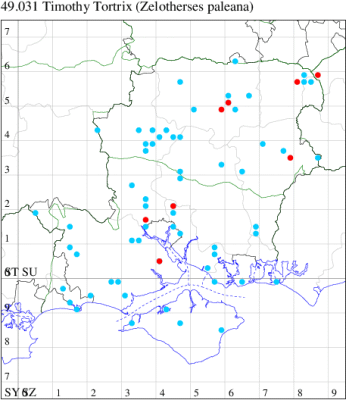
Records by year
Records by week (adult)
Records by week (larval)
Record Details
VC11: Lee, nr Nursling, one, 11 Jun (CTha); Dibden Purlieu, one, 25 Jul (RAC); Allbrook, two, 19 Jul (SIng);
VC12: Kempshott, one, 22 Aug (GAH); Basingstoke, one, 12 Jun (RHil); Whitehill, one, 26 Jun (ASto); Minley Wood, one, field observation, 09 Jun; one, field observation, 14 Jun (BDal); Hawley Meadows, present, field observation, 06 Jun (PBam)
49.037 [B&F: 0993] Cyclamen Tortrix Clepsis spectrana (Treitschke, 1830) - Common
Common in damp woodland, fens, marshes and gardens throughout the British Isles. Widespread and fairly common in Hampshire, but there are no recent records from the Isle of Wight. Wingspan male 15-22 mm, female 17-24 mm. Yellowish forms of this species may be distinguished from C. rurinana by the stronger markings on the costa of the forewing and the more uniform whitish grey hindwing. Larva feeds on many different herbaceous plants, including Willowherb, Meadowsweet, Sea Wormwood and Sea Lavender, and, in gardens, on Cyclamen, living within a spun or rolled leaf.
Records prior to 2021
| Vice County | #Records | #Individuals | First Record | Last Record |
|---|---|---|---|---|
| 10 | 64 | 126 | 1856 | 2020 |
| 11 | 317 | 481 | 1971 | 2020 |
| 12 | 167 | 269 | 1983 | 2020 |
2021 records
| Vice County | #Records | #Individuals | Max Quantity |
|---|---|---|---|
| 10 | 4 | 8 | 5 |
| 11 | 6 | 11 | 6 |
| 12 | 4 | 5 | 2 |
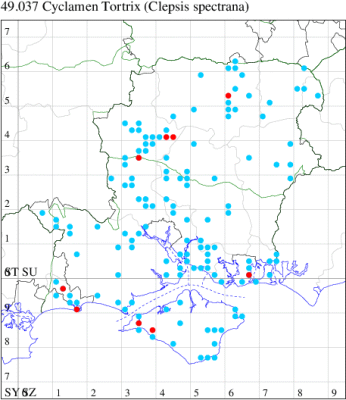
Records by year
Records by week (adult)
Records by week (larval)
Record Details
VC10: Freshwater, one, 29 Jun; one, 30 Jun; one, gen det, 26 Jun; Brook Down, five, 28 Jun (PBar);
VC11: Stockbridge Down NT, one, 05 Sep (GCE); Portsmouth, one, 20 Jul; one, 17 Sep (IRT); Hurn, one, 02 Jul; Hengistbury Head, seven, 11 Aug (MJef);
VC12: Barton Stacey, one, 24 Aug; Bullington, two, 16 Jul; one, 19 Sep (GCE); Basingstoke, one, 21 Aug (MJW)
49.038 [B&F: 0994] Clepsis consimilana (Hübner, [1817]) - Common
Common in gardens throughout much of the British Isles. In Hampshire and on the Isle of Wight widespread and common. Wingspan male 13-17 mm, female 15-19 mm. Distinguished by its small size, indistinct forewing markings and the two small fuscous spots on the dorsum. Larva feeds on Wild Privet, Garden Privet, Ash, Lilac and Ivy, preferring dead leaves, living between leaves spun together with silk.
Records prior to 2021
| Vice County | #Records | #Individuals | First Record | Last Record |
|---|---|---|---|---|
| 10 | 258 | 428 | 1850 | 2020 |
| 11 | 2234 | 3719 | 1969 | 2020 |
| 12 | 770 | 1429 | 1987 | 2020 |
2021 records
| Vice County | #Records | #Individuals | Max Quantity |
|---|---|---|---|
| 10 | 31 | 59 | 8 |
| 11 | 104 | 152 | 5 |
| 12 | 33 | 55 | 10 |
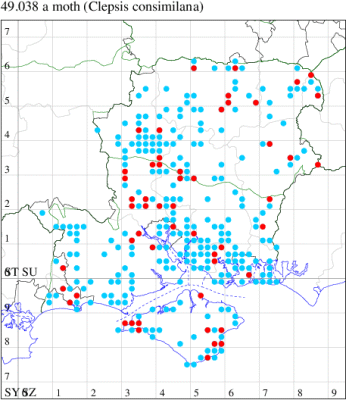
Records by year
Records by week (adult)
Records by week (larval)
Record Summary
VC10: Earliest: Freshwater, 20 Jun, 2 (DCoo) Latest: Shanklin, 04 Aug, 1 (IOut) Max count: Freshwater, 13 Jul, 8 (DCoo)
VC11: Earliest: Allbrook, 14 Jun, 1 (SIng) Latest: Southampton, 17 Oct, 1 (MGP) Max count: Valley Park, Chandlers Ford, 22 Jul, 5 (KArb)
VC12: Earliest: Basingstoke, 01 Jun, 1 (GAH) Latest: Hammer Vale, 24 Oct, 1 (ASwa) Max count: Basingstoke, 19 Jul, 10 (MJW)
49.039 [B&F: 0998] Light Brown Apple Moth Epiphyas postvittana (Walker, 1863) - Common
Common in gardens throughout much of the country. Thoroughly naturalised, through accidental introduction in garden plants, this native of Australia was first reported in Britain from Cornwall in 1936, it has since expanded its range across most of the country, and can be abundant where it occurs. Shows a marked preference for urban gardens, remaining relatively rare away from towns, and despite its common name, is neither light brown, nor particularly fond of apple! Widespread and common in Hampshire and on the Isle of Wight. Wingspan male 16-21 mm, female 17-25 mm. The male is usually distinguished by the abrupt division of the forewing medially into a pale basal area and darker apical area, and the female by its large size and relatively elongate forewing, often with greatly reduced markings [Bradley]. Larva polyphagous on a wide range of plants, including Evergreen Spindle, causing sufficient damage to fruit trees to be a serious pest in some areas.
Records prior to 2021
| Vice County | #Records | #Individuals | First Record | Last Record |
|---|---|---|---|---|
| 10 | 2095 | 7377 | 1991 | 2020 |
| 11 | 25090 | 110556 | 1977 | 2020 |
| 12 | 5113 | 23806 | 1993 | 2020 |
2021 records
| Vice County | #Records | #Individuals | Max Quantity |
|---|---|---|---|
| 10 | 238 | 1626 | 239 |
| 11 | 1161 | 3486 | 37 |
| 12 | 382 | 1128 | 36 |
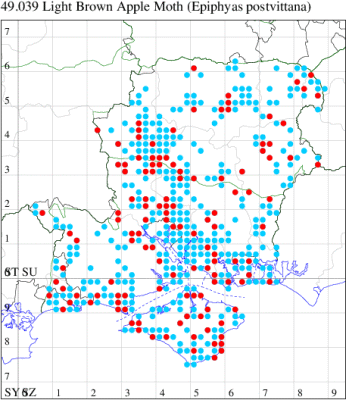
Records by year
Records by week (adult)
Records by week (larval)
Record Summary
VC10: Earliest: Bonchurch, 21 Feb, 2 (JHa) Latest: Totland, 31 Dec, 5 (RTer) Max count: Brook, 07 Oct, 239 (DWes & REJ)
VC11: Earliest: Fareham, 13 Jan, 2 (KJW) Latest: Swaythling, Southampton, 31 Dec, 1 (MEdg) Max count: Christchurch, 05 Sep, 37 (PHug)
VC12: Earliest: Basingstoke, 13 Jan, 1 (GAH) Latest: Alton, 31 Dec, 1 (DBO) Max count: Basingstoke, 06 Sep, 36 (MJW)
49.040 [B&F: 1001] Lozotaeniodes formosana (Frölich, 1830) - Common
Common in pine woodland throughout much of southern England and Wales. First recorded in north-west Surrey in 1945, near the Hampshire border, this species is now widespread in southern Britain. In Hampshire increasingly common, but remaining very rare on the Isle of Wight. Wingspan 20-26 mm. The bold reticulate forewing pattern is very characteristic [Bradley]. Larva feeds on Scots Pine.
Records prior to 2021
| Vice County | #Records | #Individuals | First Record | Last Record |
|---|---|---|---|---|
| 10 | 74 | 90 | 1950 | 2020 |
| 11 | 912 | 1080 | 1973 | 2020 |
| 12 | 276 | 326 | 1981 | 2020 |
2021 records
| Vice County | #Records | #Individuals | Max Quantity |
|---|---|---|---|
| 10 | 13 | 27 | 8 |
| 11 | 23 | 23 | 3 |
| 12 | 19 | 25 | 5 |
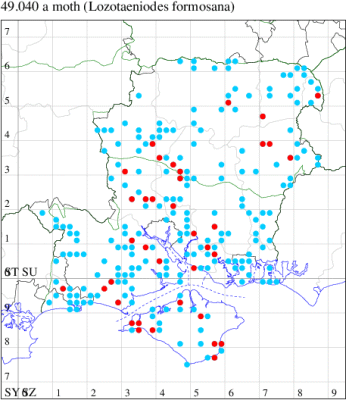
Records by year
Records by week (adult)
Records by week (larval)
Record Details
VC10: Totland, one, 22 Jul (RTer); Freshwater Bay, one, 29 Jun (SDav); Freshwater, one, 08 Jul; one, 01 Jul; one, 07 Jul; seven, 27 Jun; two, 08 Jul; Brook Down, one, 07 Jul (PBar); Parkhurst Forest, one, 13 Jul (TJN, IMer, LFom); Bonchurch, one, 14 Jul (JHa); Newport, eight, 08 Jul (SuHug); Shanklin, one, 17 Jul; Shanklin Upper Chine, one, 21 Jul (IOut);
VC11: Marchwood, one, 02 Jul (TDCh); Woodlands, NF, present, 29 Jun (RBW); Ashurst, one, 01 Jul (RFC); Woodley, one, 14 Jul (NBin); Romsey, one, 18 Jul (NRJ); Broughton, one, 08 Jul (GCE); Stanbrige Earls, three, 15 Jun; one, 07 Jul (JRM); Dibden Purlieu, one, 03 Aug (RAC); Allbrook, one, 13 Jul; one, 18 Jul (SIng); Winchester, one, 08 Jul (THW); Brownwich cliffs, one, 16 Jul (MLO, RJD, KJW); Botley Wood, one, 30 Jul (RJD, DWal, KJW det. RJD); Fareham, one, 09 Jul (MLO); Botley, one, 09 Jul (SLB); Shirrell Heath, one, 14 Jul (LEdg); Hurn, one, 27 Jun (MJef); Sway, one, 13 Jun (S&SLan); present, 18 Jul (DMui); Milford on Sea, one, 30 Jun; one, 14 Jul; one, 18 Jul (MMcM);
VC12: Chilbolton, one, 10 Jul (SLE det. GCE); Little Somborne, one, 12 Jul; Crawley, two, 13 Jul; one, 13 Jul; one, 13 Jul (GCE); Harestock, one, 30 Jun; one, 01 Jul (GRog); Basingstoke, one, 14 Jul (RHil); Alton, two, 25 Jul (DBO); one, 29 Jun; one, 14 Jul (NDP); Whitehill, two, 28 Jun; one, 30 Jun; one, 02 Jul; five, 11 Jul; one, 13 Jul (ASto); South Warnborough, present, 22 Jul (E&PR); Farnborough, one, 29 Jun; one, 01 Jul (KBW)
49.044 [B&F: 1025] Tortricodes alternella ([Denis & Schiffermüller], 1775) - Common
Common, in deciduous woodland, especially of oak, throughout Britain. In Hampshire, widely distributed and relatively common in oak woodland, appearing in 2009 in considerable numbers, including in many gardens well away from oak woodland. Likely to be under-recorded on the Isle of Wight with few recent records. Wingspan 19-23mm. One of the earliest Tortricids to emerge in Spring and unlikely to be confused with hibernating Tortricids which may be on the wing in early spring [Bradley]. Larva feeds on Oak, Hornbeam, Hazel, Hawthorn, Blackthorn, Lime and Birch, living between leaves spun together with silk, and over-wintering as a pupa.
Records prior to 2021
| Vice County | #Records | #Individuals | First Record | Last Record |
|---|---|---|---|---|
| 10 | 47 | 123 | 1900 | 2020 |
| 11 | 603 | 2836 | 1970 | 2020 |
| 12 | 281 | 1421 | 1976 | 2020 |
2021 records
| Vice County | #Records | #Individuals | Max Quantity |
|---|---|---|---|
| 10 | 2 | 2 | 1 |
| 11 | 22 | 268 | 75 |
| 12 | 16 | 39 | 14 |
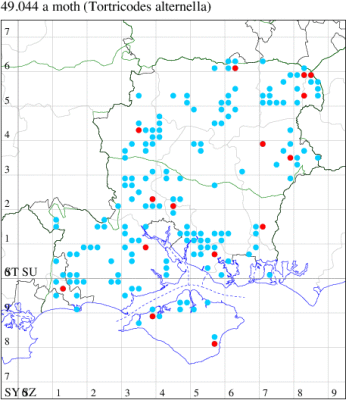
Records by year
Records by week (adult)
Records by week (larval)
Record Details
VC10: Cranmore, one, 22 Feb (CHic); Shanklin, one, 24 Feb (IOut);
VC11: Marchwood, four, 24 Feb (TDCh); Romsey, 12, 16 Feb; 20, 17 Feb; 61, 20 Feb; 20, 21 Feb; five, 22 Feb; 75, 23 Feb; 45, 24 Feb; three, 03 Mar (NRJ); Allbrook, one, 24 Feb (SIng); Fareham, one, 21 Feb (MLO); Horndean, one, 20 Feb; , present, 20 Feb (PHog); Hurn, one, 02 Feb; one, 17 Feb; one, 18 Feb; three, 19 Feb; five, 20 Feb; two, 21 Feb; five, 24 Feb; one, 10 Mar; one, 11 Mar (MJef);
VC12: Anna Valley, Andover, one, 21 Feb (TJN, LFom); Pamber Forest, one, 28 Jan; three, 15 Feb; four, 21 Feb; one, 18 Mar (GJD); Alton, one, 24 Feb (BCA); Whitehill, one, 24 Feb; one, 13 Mar (ASto); Church Crookham, 14, 19 Feb; four, 20 Feb (DDim); Yateley Common, one, field observation, 04 Mar; larva, one, field observation, 22 May; larva, one, field observation, 25 May; larva, three, field observation, 27 May; Blackwater, one, 20 Feb; one, 23 Feb (BDal)
49.047 [B&F: 1030] Eana incanana (Stephens, 1852) - Local
Local in woodland throughout much of Britain. In Hampshire fairly widespread, but not particularly common, in most areas, except for the New Forest. It is relatively scarce on the Isle of Wight. Wingspan 17-22 mm. The rounded forewing and conspicuous curved subbasal fascia are characteristic [Bradley]. Larva feeds in a web in the flowers of Bluebell and possibly Wild Garlic (references to other pabula, such as Ox-eye Daisy, are potentially doubtful).
Records prior to 2021
| Vice County | #Records | #Individuals | First Record | Last Record |
|---|---|---|---|---|
| 10 | 4 | 4 | 1933 | 2020 |
| 11 | 78 | 116 | 1990 | 2020 |
| 12 | 90 | 113 | 1994 | 2020 |
2021 records
| Vice County | #Records | #Individuals | Max Quantity |
|---|---|---|---|
| 10 | 2 | 2 | 1 |
| 11 | 3 | 4 | 2 |
| 12 | 5 | 7 | 2 |
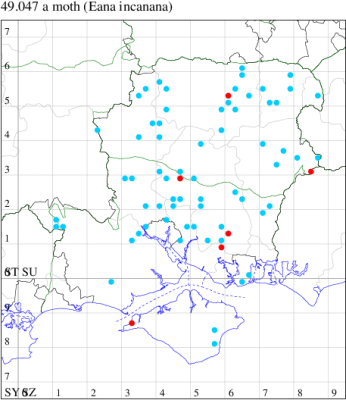
Records by year
Records by week (adult)
Records by week (larval)
Record Details
VC10: Totland, one, 23 Jul; one, 26 Jul (RTer);
VC11: Winchester, one, 25 Jul (THW); Wickham, two, to light, 09 Jul (KCok, RJD, MLO, ADT, KJW); West Walk, one, 23 Jul (RJD, MLO, ADT, DWal, KJW);
VC12: Basingstoke, one, 25 Jun; one, 19 Jul; two, 22 Jul; two, 10 Aug (MJW); Liphook, Hampshire, one, 19 Jul (RForr)
49.049 [B&F: 1024] Light Grey Tortrix Cnephasia incertana (Treitschke, 1835) - Common
Common in woodland edges and hedgerows throughout much of the British Isles. In Hampshire and on the Isle of Wight widespread and common. Wingspan 14-18 mm. Another small Cnephasia about the size of C. asseclana, from which distinguished by the weaker irroration in the forewing (not as pale as C. genitalana). Can be determined with certainty only by dissection of the genitalia. Larva feeds on Greater Plantain, Ribwort Plantain, Common Sorrel, Sheep's Sorrel and similar, living within a spinning.
Records prior to 2021
| Vice County | #Records | #Individuals | First Record | Last Record |
|---|---|---|---|---|
| 10 | 22 | 16 | 1856 | 2020 |
| 11 | 300 | 409 | 1971 | 2018 |
| 12 | 63 | 136 | 1996 | 2015 |
2021 records
| Vice County | #Records | #Individuals | Max Quantity |
|---|---|---|---|
| 11 | 1 | 1 | 1 |
| 12 | 1 | 3 | 3 |
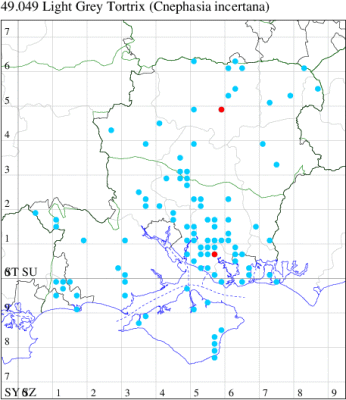
Records by year
Records by week (adult)
Records by week (larval)
Record Details
VC11: Fareham, one, gen det, 09 Jun (MLO det. );
VC12: Kempshott, three, 03 Aug (GAH)
49.050 [B&F: 1020] Grey Tortrix Cnephasia stephensiana (Doubleday, [1849]) - Common
Common in a wide range of habitats throughout much of the British Isles. In Hampshire and on the Isle of Wight widespread and generally the commonest of the Cnephasia which occur in the county. Wingspan 18-22 mm. The largest of the British Cnephasia with relatively broad forewings having a dark ground colour and dark grey fascia; small specimens may be confused with C. asseclana but in that species the costal spot of the forewing is stronger and usually extends to the termen. Often readily identified on size alone, but can be determined with certainty only by dissection of the genitalia. Larva polyphagous on various herbaceous plants, living within a spun or rolled leaf.
Records prior to 2021
| Vice County | #Records | #Individuals | First Record | Last Record |
|---|---|---|---|---|
| 10 | 37 | 31 | 1850 | 2020 |
| 11 | 712 | 1960 | 1964 | 2020 |
| 12 | 442 | 952 | 1971 | 2020 |
2021 records
| Vice County | #Records | #Individuals | Max Quantity |
|---|---|---|---|
| 10 | 7 | 12 | 4 |
| 11 | 8 | 8 | 1 |
| 12 | 5 | 7 | 3 |
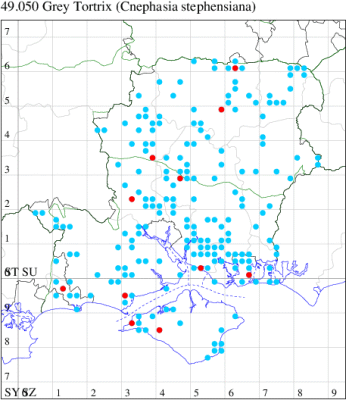
Records by year
Records by week (adult)
Records by week (larval)
Record Details
VC10: Totland, one, 26 Jun; one, 22 Jul; four, 23 Jul; three, not gen det - good condition, 24 Jul; one, 25 Jul; one, 26 Jul (RTer); Mottistone Down, one, gen det, 07 Jul (PBar);
VC11: Stanbrige Earls, one, 26 Jun (JRM); Winchester, one, 30 Jun (THW); Titchfield Haven NNR, one, 25 Jun (RJD, DWal, KJW, RCar, DHun det. RJD); Portsmouth, one, gen det, 15 Jul; one, gen det, 16 Jul (IRT); Hurn, one, 19 Jul (MJef); Pennington, one, 26 May; one, 28 May (RFC);
VC12: Little Somborne, one, 24 Jun (GCE); Basingstoke, one, 16 Jun; Kempshott, one, 06 Jul (GAH); Pamber Forest, one, 24 Jun; three, 28 Jun (GJD)
49.051 [B&F: 1021] Flax Tortrix Cnephasia asseclana ([Denis & Schiffermüller], 1775) - Common
Common in gardens, farmland and other open areas throughout much of the British Isles. In Hampshire and on the Isle of Wight widespread and common. Wingspan 15-18 mm. Distinguished from C. pasiuana by the usually stronger and more variegated forewing pattern with a relatively narrow median fascia. Smaller than C. stephensiana but with similar dark markings so could quite easily be confused with small specimens of that species. Can be determined with certainty only by dissection of the genitalia. Larva polyphagous on various herbaceous plants, living within a spun or rolled leaf.
Records prior to 2021
| Vice County | #Records | #Individuals | First Record | Last Record |
|---|---|---|---|---|
| 10 | 13 | 6 | 1900 | 2020 |
| 11 | 402 | 541 | 1972 | 2020 |
| 12 | 63 | 137 | 1976 | 2020 |
2021 records
| Vice County | #Records | #Individuals | Max Quantity |
|---|---|---|---|
| 10 | 2 | 2 | 1 |
| 11 | 1 | 1 | 1 |
| 12 | 1 | 2 | 2 |
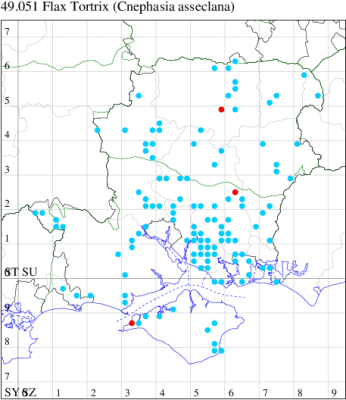
Records by year
Records by week (adult)
Records by week (larval)
Record Details
VC10: Totland, one, 24 Jun; one, 24 Jul (RTer);
VC11: West Meon, one, gen det, 02 Jul (RJD, MLO, ADT, DWal, KJW);
VC12: Kempshott, two, 03 Aug (GAH)
49.054 [B&F: 1023] Cnephasia genitalana Pierce & Metcalfe, 1922 - Local
Local in gardens, woodland edges and other open areas in parts of south-eastern England and Wales. In Hampshire there has been an increase in the number of records received in the first decade of the century, and the species has been found to favour certain gardens in Waterlooville, Basingstoke and Southsea, amongst others. Recorded on the Isle of Wight for the first time at Totland in 2009. Wingspan 15-18 mm. The whitish slate-grey general coloration and usually obsolescent markings are characteristic of this species. Can be determined with certainty only by dissection of the genitalia. Larva feeds on various Ranunculaceae and Compositae, living between flowers spun together with silk.
Records prior to 2021
| Vice County | #Records | #Individuals | First Record | Last Record |
|---|---|---|---|---|
| 10 | 1 | 1 | 2009 | 2009 |
| 11 | 69 | 85 | 1991 | 2019 |
| 12 | 33 | 45 | 2004 | 2019 |
2021 records
| Vice County | #Records | #Individuals | Max Quantity |
|---|---|---|---|
| 10 | 3 | 3 | 1 |
| 12 | 3 | 5 | 3 |
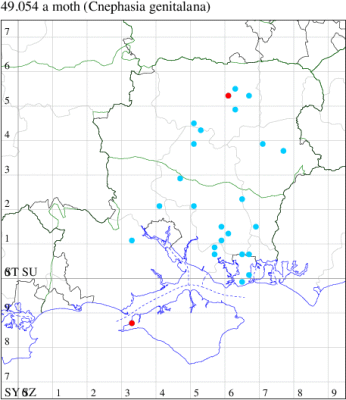
Records by year
Records by week (adult)
Records by week (larval)
Record Details
VC10: Totland, one, 24 Jul; one, 26 Jul; one, 29 Jul (RTer);
VC12: Basingstoke, one, 19 Jul; one, 26 Jul; three, 03 Aug (MJW)
49.055 [B&F: 1018] Cnephasia communana (Herrich-Schäffer, 1851) - Local
Local with a preference for dry pastures, downland and fens throughout England and Wales. The earliest Cnephasia to emerge and the only one on the wing during most of May, about the size of Grey Tortrix C. stephensiana and usually with a paler ground colour and paler brownish fascia, but like all Cnephasia, identification can only be confirmed by dissection of genitalia. Like its congeners, undoubtedly under-recorded. Reported from Totland, Isle of Wight in 2021 (and again in 2022), the first report from the island since the mid-20th century. Wingspan 18-22 mm. Larva feeds on various herbaceous plants, living within a spun or rolled leaf.
Records prior to 2021
| Vice County | #Records | #Individuals | First Record | Last Record |
|---|---|---|---|---|
| 10 | 3 | 0 | 1900 | 1947 |
| 11 | 51 | 60 | 1976 | 2020 |
| 12 | 22 | 31 | 1994 | 2013 |
2021 records
| Vice County | #Records | #Individuals | Max Quantity |
|---|---|---|---|
| 10 | 1 | 1 | 1 |
| 11 | 1 | 1 | 1 |
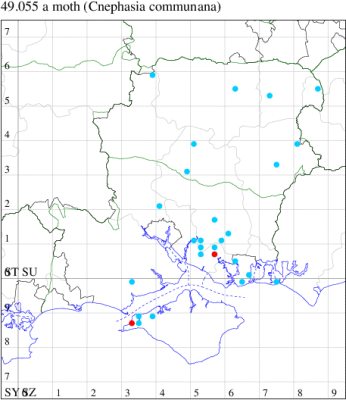
Records by year
Records by week (adult)
Records by week (larval)
Record Details
VC10: Totland, one, not gen det, only compared to examples in the collection - it wasn't retained as it seemed too early for the others it could be confused with, 28 May (RTer);
VC11: Fareham, one, gen det, 26 May (MLO det. )
49.057 [B&F: 1016] Cnephasia longana (Haworth, 1811) - Common
Common on downland and rough ground throughout much of England and Wales. In Hampshire fairly well distributed in the east of the county. Recorded on the Isle of Wight for the first time since 1850 at Compton Down and Brook in 2011. Wingspan 15-22 mm. One of the more easily identifiable Cnephasia species, the male differs from other species in the unicolorous ochreous forewing; in the female the characteristic markings are ochreous-brown. Larva feeds within flowerheads of various Umbelliferae, living between flowers spun together with silk, and over-wintering in a cocoon.
Records prior to 2021
| Vice County | #Records | #Individuals | First Record | Last Record |
|---|---|---|---|---|
| 10 | 12 | 10 | 1850 | 2019 |
| 11 | 111 | 1394 | 1974 | 2019 |
| 12 | 29 | 35 | 1998 | 2019 |
2021 records
| Vice County | #Records | #Individuals | Max Quantity |
|---|---|---|---|
| 11 | 2 | 2 | 1 |
| 12 | 1 | 1 | 1 |
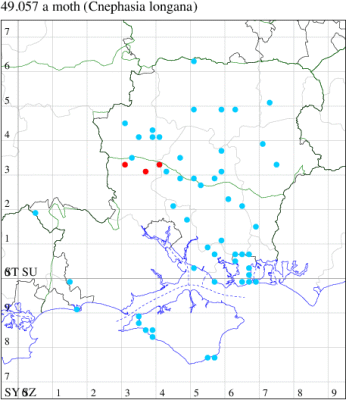
Records by year
Records by week (adult)
Records by week (larval)
Record Details
VC11: Broughton, one, 15 Aug; Ashley, one, 24 Jul (GCE);
VC12: Crawley, one, 27 Aug (GCE)
49.058 [B&F: 1034] Spatalistis bifasciana (Hübner, [1787]) - Local
Local in woodland edges in parts of southern England and southern Wales. In Hampshire a rare or, more probably, overlooked species, with notable populations in Pamber Forest and Botley Wood. On the Isle of Wight, first recorded in 1972 in Parkhurst Forest, with no other records received until 2009, when one was at Freshwater. Wingspan 12-14 mm. The small size of this species and the dark coloration and ochreous-yellow apical area of the forewing are characteristic [Bradley], although it does bear a superficial resemblance to the far more common Pseudargyrotoza conwagana. Larva feeds within berries of Buckthorn, Alder Buckthorn and Dogwood.
Records prior to 2021
| Vice County | #Records | #Individuals | First Record | Last Record |
|---|---|---|---|---|
| 10 | 15 | 22 | 1972 | 2019 |
| 11 | 51 | 65 | 1974 | 2020 |
| 12 | 34 | 60 | 1995 | 2017 |
2021 records
| Vice County | #Records | #Individuals | Max Quantity |
|---|---|---|---|
| 11 | 2 | 2 | 1 |
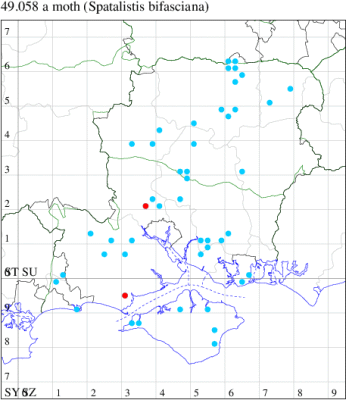
Records by year
Records by week (adult)
Records by week (larval)
Record Details
VC11: Romsey, one, 14 Jun (MBak); Pennington, one, 19 Jul (RFC)
49.059 [B&F: 1033] Green Oak Tortrix Tortrix viridana Linnaeus, 1758 - Common
Common in oak woodland, woodland, parks, gardens and areas with scattered trees throughout much of the British Isles. In Hampshire and on the Isle of Wight can be abundant in oak woods, though prone to annual fluctuations, with larvae forming the staple diet for insectivorous birds and their young, but such abundance appears to becoming rarer. Wingspan 17-24 mm. This species is unique amongst the British Tortricids in having a light green, almost unicolorous forewing [Bradley]. Larva feeds on Oak and deciduous trees, living within a spun or rolled leaf, over-wintering as an egg
Records prior to 2021
| Vice County | #Records | #Individuals | First Record | Last Record |
|---|---|---|---|---|
| 10 | 281 | 1450 | 1972 | 2020 |
| 11 | 1918 | 7147 | 1958 | 2020 |
| 12 | 805 | 10744 | 1971 | 2020 |
2021 records
| Vice County | #Records | #Individuals | Max Quantity |
|---|---|---|---|
| 10 | 16 | 56 | 25 |
| 11 | 58 | 304 | 75 |
| 12 | 74 | 412 | 65 |
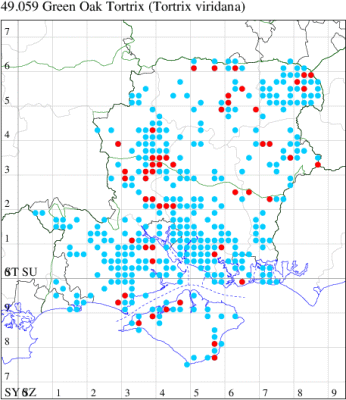
Records by year
Records by week (adult)
Records by week (larval)
Record Summary
VC10: Earliest: Cranmore, 16 Jun, 1 (CHic) Latest: Parkhurst Forest, 13 Jul, 2 (TJN, IMer, LFom) Max count: Walter's Copse, Newtown, 04 Jul, 25 (PBar)
VC11: Earliest: Eastleigh, 06 Jun, 0 (iNat) Latest: Marchwood, 19 Aug, 1 (TDCh) Max count: Wickham, 09 Jul, 75 (KCok, RJD, MLO, ADT, KJW)
VC12: Earliest: Basingstoke, 12 Jun, 1 (MDuf) Latest: Harewood Forest, 21 Jul, 3 (GCE) Max count: Great Haughurst Copse, Axmansford, 08 Jul, 65 (ACB, GJD)
49.060 [B&F: 1032] Aleimma loeflingiana (Linnaeus, 1758) - Common
Common in oak woodland, areas with scattered trees, parkland and gardens throughout the British Isles. Widespread and common in Hampshire and on the Isle of Wight. Wingspan 14-21 mm. The angular shape of the forewing and the characteristic almost reticulate pattern distinguish this species [Bradley]. Larva feeds on Oak, living within a spun or rolled leaf, and over-wintering as an egg.
Records prior to 2021
| Vice County | #Records | #Individuals | First Record | Last Record |
|---|---|---|---|---|
| 10 | 88 | 181 | 1856 | 2020 |
| 11 | 1178 | 3090 | 1958 | 2020 |
| 12 | 575 | 4834 | 1971 | 2020 |
2021 records
| Vice County | #Records | #Individuals | Max Quantity |
|---|---|---|---|
| 10 | 11 | 16 | 3 |
| 11 | 58 | 218 | 44 |
| 12 | 47 | 152 | 17 |
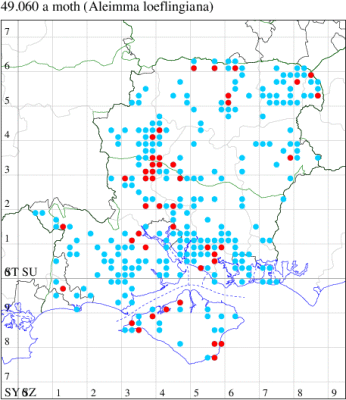
Records by year
Records by week (adult)
Records by week (larval)
Record Summary
VC10: Earliest: Totland, 20 Jun, 1 (RTer) Latest: Shanklin Upper Chine, 18 Jul, 1 (IOut) Max count: Freshwater Bay, 29 Jun, 3 (SDav)
VC11: Earliest: Marchwood, 16 Jun, 1 (TDCh) Latest: Botley Wood, 30 Jul, 1 (RJD, DWal, KJW) Max count: Winter Down Copse, Little Somborne, 30 Jun, 44 (GCE)
VC12: Earliest: Crawley, 14 Jun, 1 (GCE) Latest: Goodworth Clatford, 21 Jul, 1 (GCE) Max count: Crawley, 28 Jun, 17 (GCE)
49.061 [B&F: 1037] Acleris holmiana (Linnaeus, 1758) - Common
Common in gardens, hedgerows and woodland throughout much of the British Isles, but not in northern Scotland. In Hampshire and on the Isle of Wight scattered records of individuals or small groups indicate a low population density. Wingspan 10-15 mm. Immediately recognised by the conspicuous white costal marking on the forewing [Bradley]. Larva feeds on Apple, Plum, Blackthorn, Cotoneaster, Pear, Rowan and similar, living within a spun or rolled leaf, over-wintering as an egg.
Records prior to 2021
| Vice County | #Records | #Individuals | First Record | Last Record |
|---|---|---|---|---|
| 10 | 23 | 20 | 1893 | 2020 |
| 11 | 83 | 128 | 1974 | 2019 |
| 12 | 61 | 73 | 1993 | 2020 |
2021 records
| Vice County | #Records | #Individuals | Max Quantity |
|---|---|---|---|
| 10 | 2 | 2 | 1 |
| 11 | 2 | 2 | 1 |
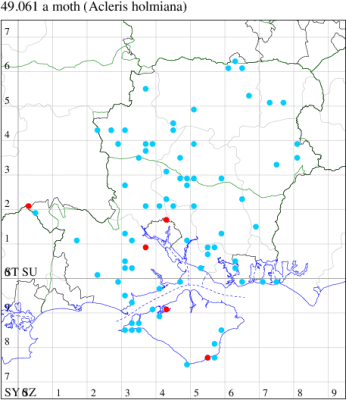
Records by year
Records by week (adult)
Records by week (larval)
Record Details
VC10: Newtown Meadows, one, field observation, 11 Aug (DCoo); Rew Down, Ventnor, one, 15 Jul (PBar);
VC11: Marchwood, one, 16 Jul (TDCh); Swaythling, Southampton, one, 27 Jul (MEdg)
49.062 [B&F: 1036] Acleris forsskaleana (Linnaeus, 1758) - Common
Common in woodland and gardens throughout England and Wales. Widespread and common in Hampshire and on the Isle of Wight. Wingspan 12-19 mm. The pale yellow ground colour and strongly reticulate pattern of the forewing distinguish this species [Bradley]. Larva feeds on Field Maple and Sycamore, living within a spun or rolled leaf, over-wintering as a small larva.
Records prior to 2021
| Vice County | #Records | #Individuals | First Record | Last Record |
|---|---|---|---|---|
| 10 | 130 | 200 | 1893 | 2020 |
| 11 | 967 | 1262 | 1972 | 2020 |
| 12 | 748 | 1194 | 1976 | 2020 |
2021 records
| Vice County | #Records | #Individuals | Max Quantity |
|---|---|---|---|
| 10 | 11 | 23 | 6 |
| 11 | 66 | 86 | 7 |
| 12 | 75 | 117 | 6 |
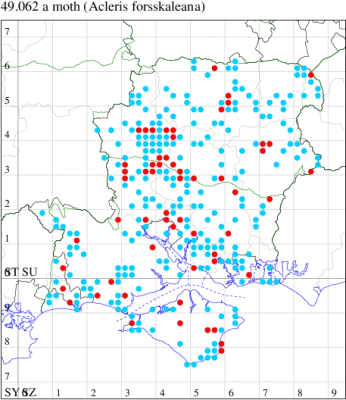
Records by year
Records by week (adult)
Records by week (larval)
Record Summary
VC10: Earliest: Parkhurst Forest, 13 Jul, 1 (TJN, IMer, LFom) Latest: Freshwater, 20 Aug, 1 (DCoo) Max count: Plaish, Carisbrooke, 22 Jul, 6 (KRyl)
VC11: Earliest: Swaythling, Southampton, 02 Jul, 1 (MEdg) Latest: Ashley, 04 Sep, 1 (GCE) Max count: Winchester, 16 Jul, 7 (THW)
VC12: Earliest: Blackwater, 03 Jul, 1 (BDal) Latest: Crawley, 07 Sep, 1 (GCE) Max count: Blackwater, 21 Jul, 6 (BDal)
49.066 [B&F: 1038] Acleris laterana (Fabricius, 1794) - Common
Common in woodland throughout much of the British Isles. In Hampshire and on the Isle of Wight widespread and fairly common, perhaps under-recorded in some areas. Wingspan 15-20 mm. Certain forms of this species closely resemble forms of A. comariana, from which reliably separated by dissection of the genitalia. The brownish f. perplexana may be confused with f. castaneana of A. schalleriana, but may be distinguished by the comparatively smooth costa of the forewing [Bradley]. Larva feeds on Willow, Bilberry, Raspberry, Blackthorn, Rowan and similar, living within a spun or rolled leaf, over-wintering as an egg.
Records prior to 2021
| Vice County | #Records | #Individuals | First Record | Last Record |
|---|---|---|---|---|
| 10 | 51 | 137 | 1976 | 2020 |
| 11 | 239 | 327 | 1970 | 2020 |
| 12 | 103 | 160 | 1976 | 2018 |
2021 records
| Vice County | #Records | #Individuals | Max Quantity |
|---|---|---|---|
| 10 | 8 | 16 | 5 |
| 11 | 1 | 1 | 1 |
| 12 | 5 | 5 | 1 |
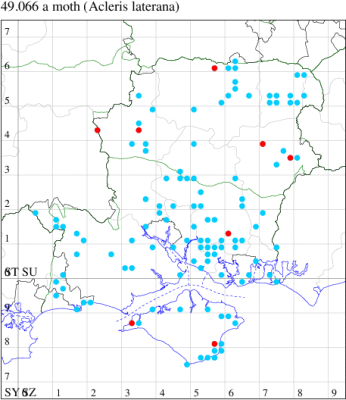
Records by year
Records by week (adult)
Records by week (larval)
Record Details
VC10: Totland, one, 28 Aug; five, one female dissected, 29 Aug; one, 30 Aug; one, 31 Aug; five, 01 Sep; one, 04 Sep; one, 27 Sep (RTer); Shanklin, one, 02 Jul (IOut);
VC11: West Walk, one, gen det, 24 Sep (RJD, MLO, ADT, KJW det. RJD);
VC12: Cholderton, one, 10 Sep (TJN); Anna Valley, Andover, one, 05 Sep (TJN, LFom); Axmansford, one, 14 Aug (ACB); Alton, one, 29 Aug (DBO); Whitehill, one, 28 Aug (ASto)
49.069 [B&F: 1041] Acleris sparsana ([Denis & Schiffermüller], 1775) - Common
Common in woodland, gardens and hedgerows throughout the British Isles. Widespread and fairly common in Hampshire and on the Isle of Wight. Wingspan male 11-18 mm, female 11-14 mm. The relatively broad forewing and predominately grey coloration are characteristic [Bradley]. Larva feeds on Beech and Sycamore, living within a spun or rolled leaf.
Records prior to 2021
| Vice County | #Records | #Individuals | First Record | Last Record |
|---|---|---|---|---|
| 10 | 121 | 148 | 1893 | 2020 |
| 11 | 423 | 503 | 1971 | 2020 |
| 12 | 204 | 245 | 1996 | 2020 |
2021 records
| Vice County | #Records | #Individuals | Max Quantity |
|---|---|---|---|
| 10 | 31 | 47 | 4 |
| 11 | 41 | 49 | 3 |
| 12 | 30 | 34 | 3 |
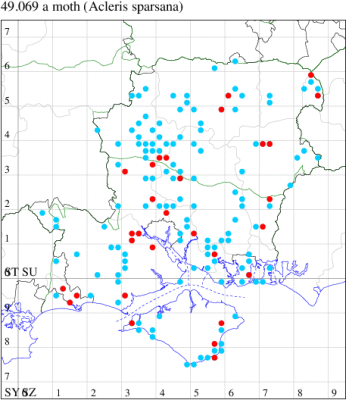
Records by year
Records by week (adult)
Records by week (larval)
Record Summary
VC10: Earliest: Freshwater, 17 Aug, 1 (DCoo) Latest: Bonchurch, 15 Dec, 1 (JHa) Max count: Bonchurch, 08 Oct, 4 (IOut)
VC11: Earliest: Portsmouth, 03 Jul, 1 (IRT) Latest: Horndean, 12 Dec, 1 (PHog) Max count: Burton, nr Christchurch, 01 Oct, 3 (JStw)
VC12: Earliest: Blackwater, 22 Sep, 2 (BDal) Latest: Alton, 18 Nov, 1 (DBO) Max count: Crawley, 12 Nov, 3 (GCE)
49.070 [B&F: 1042] Rhomboid Tortrix Acleris rhombana ([Denis & Schiffermüller], 1775) - Common
Common in hedgerows, gardens and woodland throughout the British Isles. Widespread and fairly common in Hampshire and on the Isle of Wight. Wingspan 13-21 mm. Larva feeds on various deciduous trees and shrubs, including Hawthorn, Blackthorn, Apple, Dog Rose, Hazel and Oak, living within a spun or rolled leaf.
Records prior to 2021
| Vice County | #Records | #Individuals | First Record | Last Record |
|---|---|---|---|---|
| 10 | 27 | 16 | 1856 | 2020 |
| 11 | 180 | 199 | 1971 | 2019 |
| 12 | 67 | 88 | 1994 | 2018 |
2021 records
| Vice County | #Records | #Individuals | Max Quantity |
|---|---|---|---|
| 12 | 7 | 7 | 1 |
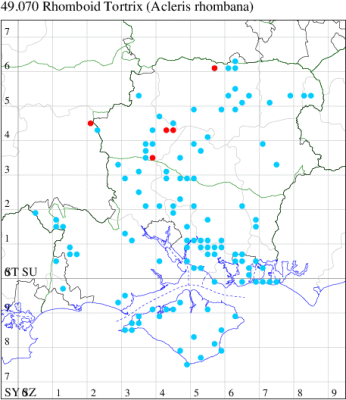
Records by year
Records by week (adult)
Records by week (larval)
Record Details
VC12: Shipton Bellinger, one, field observation, 26 Aug (BDal); Little Somborne, one, 03 Sep; Barton Stacey, one, 29 Aug; one, 02 Sep; one, 02 Sep; one, 24 Sep (GCE); Axmansford, one, 07 Oct (ACB)
49.071 [B&F: 1062] Acleris emargana (Fabricius, 1775) - Common
Common in woodland, gardens and hedgerows throughout the British Isles, less numerous in the north. Widespread and common in Hampshire and on the Isle of Wight. Wingspan 16-22 mm. The pronounced emargination on the costa of the forewing is distinctive of this species [Bradley]. Larva feeds on Sallow, Poplar and Birch, living within a spun or rolled leaf.
Records prior to 2021
| Vice County | #Records | #Individuals | First Record | Last Record |
|---|---|---|---|---|
| 10 | 62 | 67 | 1856 | 2020 |
| 11 | 327 | 456 | 1971 | 2020 |
| 12 | 153 | 213 | 1975 | 2020 |
2021 records
| Vice County | #Records | #Individuals | Max Quantity |
|---|---|---|---|
| 10 | 2 | 2 | 1 |
| 11 | 9 | 10 | 2 |
| 12 | 2 | 1 | 1 |
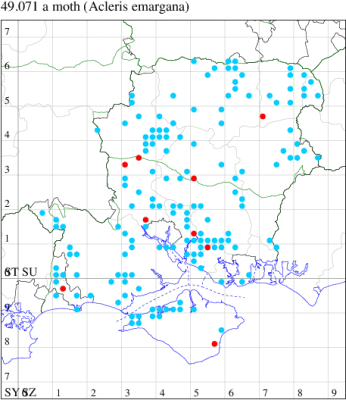
Records by year
Records by week (adult)
Records by week (larval)
Record Details
VC10: Shanklin, one, 16 Sep; one, 23 Oct (IOut);
VC11: Lee, nr Nursling, one, 23 Oct (CTha); Broughton, one, 13 Oct; Kings Somborne, one, 05 Sep (GCE); Botley Wood, one, 30 Jul (RJD, DWal, KJW); one, 10 Sep; one, 15 Oct (RJD, MLO, DWal, KJW); two, 22 Oct (RJD, MLO, ADT, DWal, KJW); Botley, one, 04 Sep (SLB); Hurn, one, 06 Sep (MJef);
VC12: Morn Hill, Winchester, one, 11 Sep (CBey, DAS, PDF); South Warnborough, present, 12 Sep (E&PR)
49.073 [B&F: 1047] Acleris schalleriana (Linnaeus, 1761) - Local
Local in gardens and woodland throughout much of England and Wales, rare in Ireland. In Hampshire and on the Isle of Wight local on the chalk, where the the larva is found mainly on Wayfaring-tree, and in the New Forest and elsewhere, where it occurs on Guelder-rose; also occurs in gardens where either (or both) species is planted. Wingspan 15-20 mm. The moderately rough-scaled anterior margin of the forewing and the enlarged costal blotch, which extends to near the apex, distinguish this species from A. laterana and A. comariana [Bradley]. Larva feeds on Guelder-rose and Wayfaring-tree, living within a spun or rolled leaf.
Records prior to 2021
| Vice County | #Records | #Individuals | First Record | Last Record |
|---|---|---|---|---|
| 10 | 33 | 14 | 1893 | 2020 |
| 11 | 225 | 263 | 1976 | 2020 |
| 12 | 166 | 192 | 1991 | 2020 |
2021 records
| Vice County | #Records | #Individuals | Max Quantity |
|---|---|---|---|
| 10 | 2 | 2 | 1 |
| 11 | 10 | 9 | 1 |
| 12 | 12 | 15 | 5 |
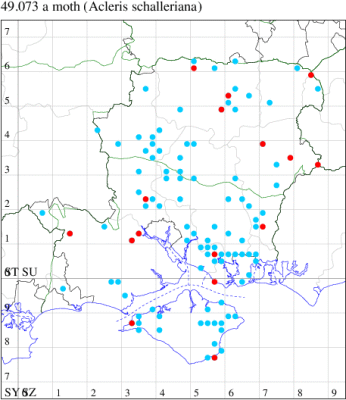
Records by year
Records by week (adult)
Records by week (larval)
Record Details
VC10: Totland, one, 08 Apr (RTer); Bonchurch, one, 30 Jun (JHa);
VC11: Fordingbridge, one, 14 Oct (SCT); Woodlands, NF, present, 07 Jul (RBW); Totton, one, 02 Oct; one, 24 Oct; one, 11 Dec (LHan); Woodley, one, indoors, 09 Nov (NBin); Fareham, one, gen det, 20 Feb (KJW det. RJD); Horndean, one, 15 Oct; one, 15 Oct (PHog); Browndown Coastal Ranges, one, gen det, 19 Nov (RJD, MLO, ADT, DWal, KJW);
VC12: Kempshott, one, 01 Aug (GAH); Ecchinswell, larva, one, field observation, on Guelder Rose, 15 Jun (MJN); Basingstoke, one, 30 Mar; five, 19 Jul; larva, present, field observation, larval spinnings in Wayfaring-tree, 21 Aug; one, 26 Sep (MJW); Alton, one, 15 Jul; one, 20 Jul; one, 31 Dec (DBO); Whitehill, one, 13 Jul (ASto); Hammer Vale, one, indoors, 15 Dec (ASwa det. MJW); Blackwater, one, field observation, 29 Sep (BDal)
49.075 [B&F: 1052] Acleris umbrana (Hübner, [1799]) - Nationally Scarce A
Nationally scarce (Na) in woodland, fens and marshes in parts of England and Wales. In Hampshire this scarce and elusive species has been knocked out of old hawthorns in the New Forest in the past, but nothing has been heard of it since the 1930s, until there was a migration event in early January 2013 when a number were trapped across southern England, during which an individual turned up in Pennington. In subsequent years the species has become increasingly frequent and appearances in the two counties are now expected annually (reported new for North Hampshire in 2022) and now probably established at low levels as a resident. Wingspan 18-23 mm. This species is similar to certain forms of A. hastiana; it may be distinguished by differences in the shape of the costa of the forewing, which in both sexes of A. hastiana appears shallowly concave beyond the middle; also, the two small but well-developed scale-tufts present in the tornal area of the forewing in A. umbrana, are not found in A. hastiana [Bradley]. Larva feeds on Blackthorn, Hawthorn, Bird Cherry and Rowan, living within a spun or rolled leaf.
Records prior to 2021
| Vice County | #Records | #Individuals | First Record | Last Record |
|---|---|---|---|---|
| 10 | 21 | 21 | 2014 | 2020 |
| 11 | 38 | 43 | 1900 | 2020 |
2021 records
| Vice County | #Records | #Individuals | Max Quantity |
|---|---|---|---|
| 10 | 3 | 4 | 2 |
| 11 | 5 | 5 | 1 |
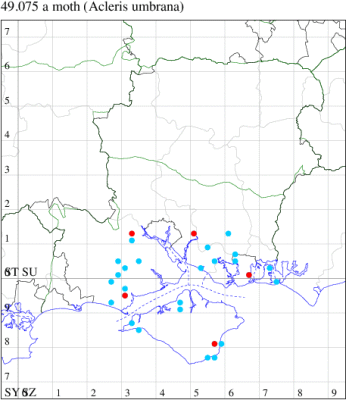
Records by year
Records by week (adult)
Records by week (larval)
Record Details
VC10: Shanklin, two, 20 Jul; one, 09 Nov; one, field observation, 16 Dec (IOut);
VC11: Totton*, one, 01 Dec (CNB); Botley, one, 16 Feb (SLB); Portsmouth, one, 17 Jul; one, 18 Jul (IRT); Pennington, one, 08 Nov (RFC)
49.076 [B&F: 1054] Acleris cristana ([Denis & Schiffermüller], 1775) - Common
Common in woodland throughout much of southern England. Reasonably well distributed across Hampshire and the Isle of Wight. Wingspan 18-22 mm. The very large coarse-scaled tuft situated towards the end of the discal cell on the forewing is peculiar to A. cristana, and is present in most forms, readily distinguishing this species from others in the genus Acleris [Bradley]. Larva feeds on various herbaceous trees and shrubs, including Blackthorn, Hawthorn, Beech, Oak, Birch, Hazel, Lime and Elm, living within a spun or rolled leaf.
Records prior to 2021
| Vice County | #Records | #Individuals | First Record | Last Record |
|---|---|---|---|---|
| 10 | 51 | 48 | 1900 | 2020 |
| 11 | 260 | 263 | 1970 | 2020 |
| 12 | 135 | 144 | 1993 | 2020 |
2021 records
| Vice County | #Records | #Individuals | Max Quantity |
|---|---|---|---|
| 10 | 3 | 4 | 2 |
| 11 | 12 | 15 | 2 |
| 12 | 6 | 6 | 1 |
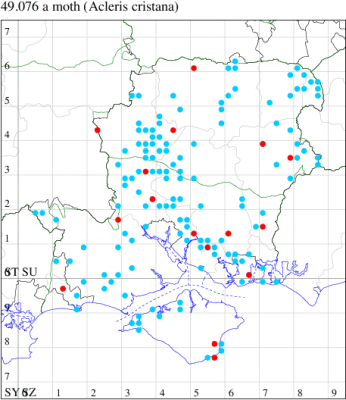
Records by year
Records by week (adult)
Records by week (larval)
Record Details
VC10: Bonchurch, one, 13 Dec; two, 15 Dec (JHa); Shanklin, one, 30 Mar (IOut);
VC11: Romsey, two, 24 Feb; two, 27 Apr; one, 30 Nov (NRJ); Ashley, one, 27 Apr (GCE); Botley Wood, two, 09 Apr (RJD, MLO, ADT, DWal, KJW); Botley, one, 03 Feb; one, 04 Apr (SLB); Portsmouth, one, 22 Jul (IRT); West Walk, one, 23 Jul (RJD, MLO, ADT, DWal, KJW); Horndean, one, 19 Feb; one, 19 Feb (PHog); Hurn, one, 24 Feb (MJef);
VC12: Cholderton, one, 21 Mar (TJN, LFom, HEdm); Barton Stacey, one, 31 Mar; one, 31 Mar (GCE); Ecchinswell, one, 31 Mar (MJN); Alton, one, field observation, 23 Aug (EFig); Whitehill, one, 20 Feb (ASto)
49.077 [B&F: 1048] Garden Rose Tortrix Acleris variegana ([Denis & Schiffermüller], 1775) - Common
Common in gardens and woodland throughout the British Isles. Widespread and common in Hampshire, distribution on the Isle of Wight apparently restricted to the south and west. Wingspan 14-19 mm. The form f. brunneana resembles the closely related species A. permutana in general appearance [Bradley]. Larva has been recorded on many species of Rosaceceae favouring Wild and Cultivated Rose, and Blackthorn, living within a spun or rolled leaf, and over-wintering as an egg.
Records prior to 2021
| Vice County | #Records | #Individuals | First Record | Last Record |
|---|---|---|---|---|
| 10 | 383 | 693 | 1856 | 2020 |
| 11 | 2444 | 3622 | 1969 | 2020 |
| 12 | 878 | 1204 | 1976 | 2020 |
2021 records
| Vice County | #Records | #Individuals | Max Quantity |
|---|---|---|---|
| 10 | 40 | 67 | 4 |
| 11 | 93 | 125 | 6 |
| 12 | 70 | 101 | 6 |
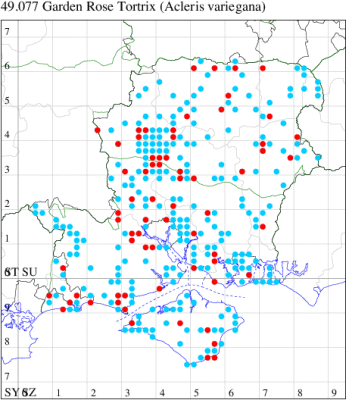
Records by year
Records by week (adult)
Records by week (larval)
Record Summary
VC10: Earliest: Rew Down, Ventnor, 15 Jul, 1 (PBar) Latest: Bonchurch, 13 Oct, 2 (JHa) Max count: Freshwater, 24 Sep, 4 (DCoo)
VC11: Earliest: Woodlands, NF, 16 Jul, 0 (RBW) Latest: Lee, nr Nursling, 15 Oct, 1 (CTha) Max count: Lee, nr Nursling, 25 Sep, 6 (CTha)
VC12: Earliest: Whitchurch, 24 Jul, 1 (ACB) Latest: Alton, 18 Oct, 1 (BCA) Max count: Barton Stacey, 24 Sep, 6 (GCE)
49.078 [B&F: 1043] Acleris aspersana (Hübner, [1817]) - Common
Common on grassland, downland, heaths and other open areas throughout the British Isles. In Hampshire and on the Isle of Wight mainly associated with chalk downland, but also found in other habitats such as marshes. Wingspan male 11-17 mm, female 11-14 mm. The small size of this species and the bright orange-yellow general coloration of the forewing are distinguishing features [Bradley]. Larva feeds on Wild Strawberry, Marsh Cinquefoil, Meadowsweet and other Rosaceae, living within a spun or rolled leaf.
Records prior to 2021
| Vice County | #Records | #Individuals | First Record | Last Record |
|---|---|---|---|---|
| 10 | 60 | 189 | 1856 | 2020 |
| 11 | 239 | 286 | 1971 | 2020 |
| 12 | 211 | 366 | 1971 | 2020 |
2021 records
| Vice County | #Records | #Individuals | Max Quantity |
|---|---|---|---|
| 10 | 1 | 1 | 1 |
| 12 | 3 | 3 | 1 |
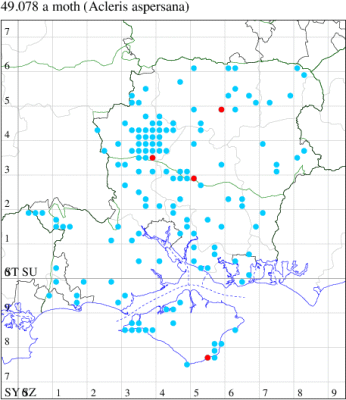
Records by year
Records by week (adult)
Records by week (larval)
Record Details
VC10: Rew Down, Ventnor, one, gen det, 15 Jul (PBar);
VC12: Little Somborne, one, 13 Aug (GCE); Morn Hill, Winchester, one, 17 Jul (CBey, DAS, PDF); Kempshott, one, 27 Aug (GAH)
49.079 [B&F: 1046] Acleris shepherdana (Stephens, 1852) - Nationally Scarce B
Nationally scarce (Nb) in fens, marshes, river-banks and other damp areas in parts of England. In Hampshire very local in marshes and water meadows on sites such as Titchfield Haven, Winnall Moors, Bransbury Common and Leckford. There have been no recent records from the Isle of Wight. Wingspan 13-16 mm. The distinctive cinnamon-brown coloration together with the reticulate pattern and the blackish plumbeous outer margin of the costal blotch of the forewing is characteristic [Bradley]. Larva feeds on Meadowsweet, living within a spun or rolled leaf.
Records prior to 2021
| Vice County | #Records | #Individuals | First Record | Last Record |
|---|---|---|---|---|
| 10 | 4 | 3 | 1926 | 1947 |
| 11 | 4 | 4 | 1971 | 2013 |
| 12 | 22 | 31 | 1988 | 2017 |
2021 records
| Vice County | #Records | #Individuals | Max Quantity |
|---|---|---|---|
| 12 | 2 | 2 | 1 |
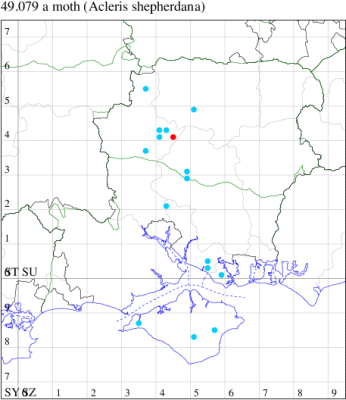
Records by year
Records by week (adult)
Records by week (larval)
Record Details
VC12: Bullington, one, 24 Aug; one, 24 Aug (GCE)
49.080 [B&F: 1053] Acleris hastiana (Linnaeus, 1758) - Common
Common in woodland, hedgerows, fens and freshwater margins throughout the British Isles. In Hampshire and on the Isle of Wight widespread and common. Wingspan 17-24 mm. A number of forms of this highly polymorphic species resemble certain forms of A. cristana, but A. hastiana can usually be distinguished by the relatively straight costa of the forewing and the presence of numerous small scale-tufts; other forms resemble A. umbrana and A. abietana, which see. Larva feeds on various species of Salix, living within a spun or rolled leaf.
Records prior to 2021
| Vice County | #Records | #Individuals | First Record | Last Record |
|---|---|---|---|---|
| 10 | 52 | 58 | 1880 | 2020 |
| 11 | 418 | 484 | 1880 | 2020 |
| 12 | 67 | 67 | 1990 | 2020 |
2021 records
| Vice County | #Records | #Individuals | Max Quantity |
|---|---|---|---|
| 10 | 8 | 9 | 2 |
| 11 | 25 | 28 | 2 |
| 12 | 3 | 3 | 1 |
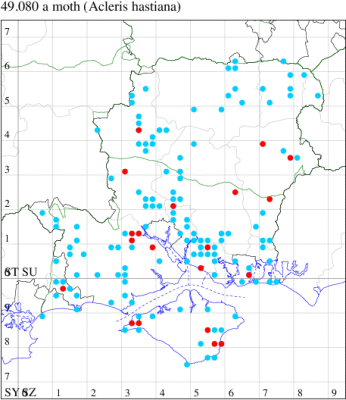
Records by year
Records by week (adult)
Records by week (larval)
Record Details
VC10: Totland, one, 24 Jul; one, 27 Dec (RTer); Freshwater, one, 15 Sep (DCoo); one, gen det, 01 Jul; one, gen det, 06 Jul (PBar); Haseley Manor, two, 13 Jul; Shanklin, one, field observation, 16 Dec; Shanklin Upper Chine, one, 18 Jul (IOut);
VC11: Marchwood, one, 12 Jul (CTha); Woodlands, NF, present, 23 Jul (RBW); Totton, one, 21 Nov (CNB); one, 31 Mar; two, 07 Jul; one, 08 Jul; one, 02 Oct; one, 05 Oct; one, 09 Oct; two, 11 Oct; one, 11 Dec; one, 16 Dec; two, 31 Dec (LHan); Broughton, one, 30 Mar (GCE); Allbrook, one, 01 Jul; one, 13 Jul; one, 15 Jul (SIng); Titchfield Haven NNR, one, 25 Jun (RJD, DWal, KJW, RCar, DHun det. RJD); Botley Wood, two, gen det, 03 Dec (RJD, MLO, DWal, KJW det. RJD); Portsmouth, one, 07 Jul (IRT); West Meon, one, 02 Jul (RJD, MLO, ADT, DWal, KJW); Petersfield, one, 17 Mar (RAll); Hurn, one, 20 Feb; one, 24 Feb; one, 19 Jul (MJef);
VC12: Anna Valley, Andover, one, 31 Dec (TJN); Alton, one, 28 Jan (DBO); Whitehill, one, 11 Jul (ASto)
49.082 [B&F: 1055] Acleris hyemana (Haworth, 1811) - Local
Local on heathland and moorland throughout much of the British Isles. In Hampshire most frequent in the New Forest; there is one record from the Isle of Wight and a few from outside the New Forest, which suggest the species may, on occasion, adapt to cultivated heathers. Wingspan 14-20 mm. The narrow forewings with prominent apex, especially in the female, and the purplish brown and silver-white coloration are characteristic [Bradley]. Larva feeds on Heather and Bilberry, living between shoots spun together with silk.
Records prior to 2021
| Vice County | #Records | #Individuals | First Record | Last Record |
|---|---|---|---|---|
| 10 | 2 | 2 | 1984 | 2009 |
| 11 | 48 | 41 | 1971 | 2020 |
| 12 | 4 | 4 | 1994 | 2015 |
2021 records
| Vice County | #Records | #Individuals | Max Quantity |
|---|---|---|---|
| 11 | 1 | 0 | 0 |
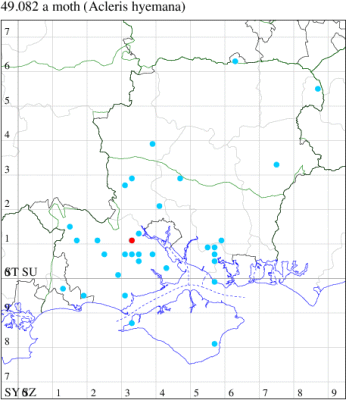
Records by year
Records by week (adult)
Records by week (larval)
Record Details
VC11: Woodlands, NF, present, 24 Feb (RBW)
49.083 [B&F: 1044] Acleris ferrugana ([Denis & Schiffermüller], 1775) - Common
Common in oak woodland, woodland and heaths throughout much of the British Isles. In Hampshire and on the Isle of Wight well distributed and reasonably common throughout. Wingspan 14-18 mm. A species associated with deciduous oak woodland, while the very similar A. notana feeds on birch. Fresh males of A. ferrugana can be distinguished by the presence of distinct scale tufts, a feature lacking on A. notana, but otherwise dissection is generally required to fully establish identity. Larva feeds on Oak and Goat Willow, living between leaves spun together with silk.
Records prior to 2021
| Vice County | #Records | #Individuals | First Record | Last Record |
|---|---|---|---|---|
| 10 | 11 | 9 | 1900 | 2020 |
| 11 | 187 | 222 | 1972 | 2020 |
| 12 | 36 | 35 | 1976 | 2019 |
2021 records
| Vice County | #Records | #Individuals | Max Quantity |
|---|---|---|---|
| 10 | 2 | 2 | 1 |
| 11 | 4 | 4 | 1 |
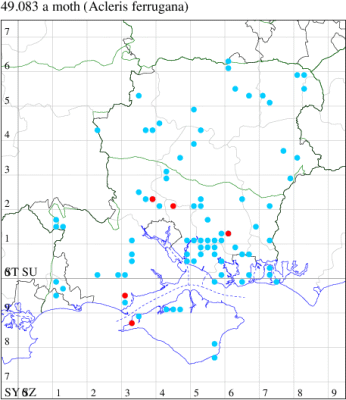
Records by year
Records by week (adult)
Records by week (larval)
Record Details
VC10: Totland, one, 24 Oct; one, 20 Nov (RTer);
VC11: Romsey, one, black scale tufts present, 03 Oct (NRJ); Allbrook, one, 23 Feb (SIng); West Walk, one, gen det, 17 Dec (RJD, MLO, DWal, KJW); Pennington, one, scale tufts as per Manley, 03 Mar (RFC)
49.084 [B&F: 1045] Acleris notana (Donovan, 1806) - Common
Common in woodland throughout much of the British Isles. In Hampshire and on the Isle of Wight well distributed and reasonably common throughout. Wingspan 14-18 mm. A species associated with birch woodland, while the very similar A. ferrugana feeds on oak. Fresh males of A. ferrugana can be distinguished by the presence of distinct scale tufts, a feature lacking on A. notana, but otherwise dissection is generally required to fully establish identity. Larva feeds on Silver Birch and Downy Birch, living between leaves spun together with silk.
Records prior to 2021
| Vice County | #Records | #Individuals | First Record | Last Record |
|---|---|---|---|---|
| 10 | 2 | 1 | 1997 | 2013 |
| 11 | 192 | 211 | 1971 | 2020 |
| 12 | 53 | 63 | 1991 | 2020 |
2021 records
| Vice County | #Records | #Individuals | Max Quantity |
|---|---|---|---|
| 11 | 1 | 1 | 1 |
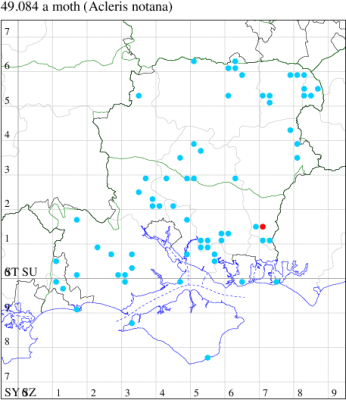
Records by year
Records by week (adult)
Records by week (larval)
Record Details
VC11: Horndean, one, 20 Feb (PHog)
49.085 [B&F: 1050] Acleris kochiella (Goeze, 1783) - Local
Local in hedgerows, gardens, orchards and parks throughout southern England, north to Yorkshire. In Hampshire and on the Isle of Wight widely distributed, but not particularly common, and most frequent on the coast east of Southampton, where the larval spinnings are recorded in small numbers in most years. Wingspan 15-18 mm. Specimens of the autumn generation of this species resemble A. logiana, but are usually greyer in general coloration [Bradley]. Larva feeds on Elm, living within a spun or rolled leaf; larvae of the summer brood are much more common than those of the spring generation.
Records prior to 2021
| Vice County | #Records | #Individuals | First Record | Last Record |
|---|---|---|---|---|
| 10 | 40 | 37 | 1900 | 2020 |
| 11 | 72 | 35 | 1978 | 2019 |
| 12 | 21 | 18 | 1996 | 2020 |
2021 records
| Vice County | #Records | #Individuals | Max Quantity |
|---|---|---|---|
| 10 | 3 | 3 | 1 |
| 11 | 1 | 1 | 1 |
| 12 | 1 | 2 | 2 |
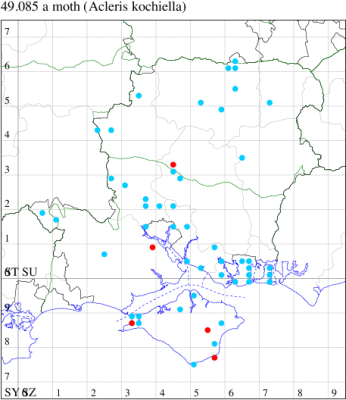
Records by year
Records by week (adult)
Records by week (larval)
Record Details
VC10: Freshwater, one, 18 Jul (DCoo); Bonchurch, one, 14 Dec (JHa); Haseley Manor, one, 19 Jul (IOut);
VC11: Marchwood, one, 15 Jul (CTha);
VC12: Littleton*, two, field observation, 16 Jan (CKni)
49.086 [B&F: 1051] Acleris logiana (Clerck, 1759) - Local
Local in birch woodland in parts of the Scottish Highlands, appearing in recent years as a migrant in southern England, where temporarily established. In Hampshire this species was first recorded in the county from larvae collected in Botley Wood in vice-county 11 by John Langmaid in 1991; a remarkable discovery, given that previously it was known only from the Highlands of Scotland. Subsequent discoveries elsewhere in birch woodland in vice-county 11 indicate that it is most likely a new arrival which is spreading; the individual shown here was the first for the north of the county, and was followed closely by another found on a tree trunk during a trapping session on Hook Common in 2003. On the Isle of Wight recorded for the first time in 1997, with another in 2012 at Cranmore. Wingspan 18-22 mm. The nominate form and f. tripunctana of this species resemble specimens of the autumn generation of A. kochiella. Larva feeds on Silver Birch and Downy Birch, living within a spun or rolled leaf.
Records prior to 2021
| Vice County | #Records | #Individuals | First Record | Last Record |
|---|---|---|---|---|
| 10 | 6 | 6 | 1997 | 2020 |
| 11 | 43 | 44 | 1991 | 2018 |
| 12 | 26 | 28 | 2003 | 2020 |
2021 records
| Vice County | #Records | #Individuals | Max Quantity |
|---|---|---|---|
| 11 | 5 | 4 | 1 |
| 12 | 2 | 2 | 1 |
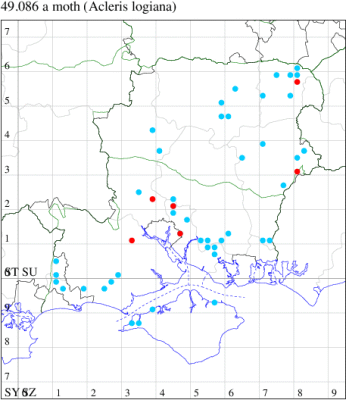
Records by year
Records by week (adult)
Records by week (larval)
Record Details
VC11: Woodlands, NF, present, 18 Jul (RBW); Romsey, one, 08 Oct (NRJ); Dumbleton's Copse, Thornhill, one, field observation, 17 Dec (PAB); Allbrook, one, 16 Oct; one, field observation, 25 Oct (SIng);
VC12: West Weavers Down, Longmoor, one, field observation, 01 Mar (EStr); Minley Wood, one, field observation, 20 Jul (BDal)
49.087 [B&F: 1061] Acleris literana (Linnaeus, 1758) - Local
Local in oak woodland throughout much of Britain, rare in Ireland. In Hampshire and on the Isle of Wight reasonably well distributed in suitable habitat throughout; perhaps benefitting from a reduction in the amount of collecting of this highly variable and attractive species. Wingspan 18-22 mm. Although an extremely variable species, readily distinguished by the light green or olive-green ground colour and black markings of the forewing, and the presence of characteristic fulvous or ferruginous markings in some of the forms [Bradley]. Larva feeds on Oak, living between leaves spun together with silk.
Records prior to 2021
| Vice County | #Records | #Individuals | First Record | Last Record |
|---|---|---|---|---|
| 10 | 37 | 42 | 1856 | 2020 |
| 11 | 202 | 212 | 1973 | 2020 |
| 12 | 61 | 62 | 1976 | 2020 |
2021 records
| Vice County | #Records | #Individuals | Max Quantity |
|---|---|---|---|
| 10 | 6 | 8 | 3 |
| 11 | 16 | 20 | 3 |
| 12 | 3 | 4 | 2 |
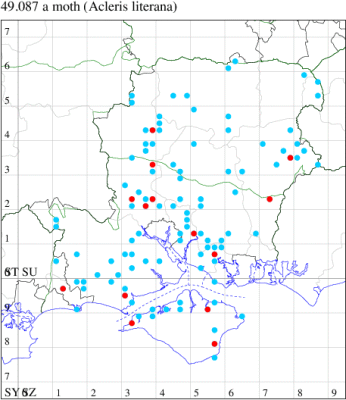
Records by year
Records by week (adult)
Records by week (larval)
Record Details
VC10: Totland, one, 14 Mar; one, 28 May (RTer); Shanklin, one, 15 Mar; three, 30 Mar; one, 20 Apr (IOut); Wootton Bridge, one, 10 May (DElm);
VC11: Romsey, two, 24 Feb (MBak); two, 20 Feb; one, 21 Feb; three, 24 Feb (NRJ); Winter Down Copse, Little Somborne, one, 01 Sep; one, 02 Jun; one, 09 May (GCE); Stanbrige Earls, one, 20 Feb; one, 09 Apr (JRM); Fareham, one, 20 Feb (KJW); Botley, one, 22 Jul; one, 14 May (SLB); Petersfield, one, 21 Feb; one, 18 Mar (RAll); Hurn, one, 20 Feb (MJef); Pennington, one, 24 Feb (RFC);
VC12: Harewood Forest, one, 01 Jun (GCE); Whitehill, two, 31 Mar; one, 04 Apr (ASto)
49.090 [B&F: 1015] Eulia ministrana (Linnaeus, 1758) - Common
Common in woodland, damp heathland and mosses throughout the British Isles. In Hampshire and on the Isle of Wight widely distributed, but not particularly common. Wingspan 18-22 mm. The moderately large size and the whitish yellow ground colour of the forewing with obscure ferruginous-brown markings are characteristic [Bradley]. Larva feeds on various deciduous trees and shrubs, including Hazel, Ash, Buckthorn, Rowan, Birch and Bilberry, living within a spun or rolled leaf.
Records prior to 2021
| Vice County | #Records | #Individuals | First Record | Last Record |
|---|---|---|---|---|
| 10 | 11 | 13 | 1929 | 2016 |
| 11 | 201 | 243 | 1900 | 2020 |
| 12 | 72 | 100 | 1974 | 2020 |
2021 records
| Vice County | #Records | #Individuals | Max Quantity |
|---|---|---|---|
| 10 | 1 | 1 | 1 |
| 11 | 18 | 21 | 3 |
| 12 | 5 | 5 | 1 |
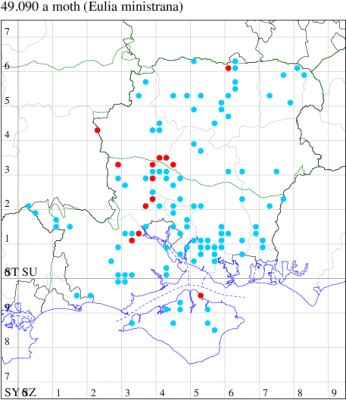
Records by year
Records by week (adult)
Records by week (larval)
Record Details
VC10: Osborne Valley Walk, one, 01 Jun (IOut);
VC11: Broughton Down, present, 12 Jun (DTay det. MBot); Woodlands, NF, present, 30 May (RBW); Totton, one, 02 Jun; one, 10 Jun; one, 11 Jun (LHan); Romsey, one, 10 Jun (MBak); one, 01 Jun; two, 02 Jun; one, 09 Jun (NRJ); Kings Somborne, one, 09 Jun; two, 09 Jun; Winter Down Copse, Little Somborne*, one, 02 Jun; three, 02 Jun; one, 02 Jun; two, 02 Jun; one, 02 Jun; one, 02 Jun; one, 02 Jun (GCE);
VC12: Cholderton, one, 02 Jul (TJN, LFom, HEdm); Little Somborne, one, 28 May; Crawley, one, 31 May; one, 14 Jun (GCE); Pamber Forest, one, 09 Jun (GJD)
49.091 [B&F: 1011] Pseudargyrotoza conwagana (Fabricius, 1775) - Common
Common in a wide range of habitats, including gardens throughout the British Isles. Widespread and common in Hampshire and on the Isle of Wight. Wingspan 18-24 mm. The general yellowish coloration and metallic irroration of the forewing and the usually conspicuous pale yellow dorsal blotch readily distinguish this species [Bradley]. Larva feeds within fruits and berries of Wild and Garden Privet, and Ash, over-wintering as a pupa.
Records prior to 2021
| Vice County | #Records | #Individuals | First Record | Last Record |
|---|---|---|---|---|
| 10 | 252 | 818 | 1856 | 2020 |
| 11 | 1283 | 3319 | 1971 | 2020 |
| 12 | 697 | 1909 | 1971 | 2020 |
2021 records
| Vice County | #Records | #Individuals | Max Quantity |
|---|---|---|---|
| 10 | 25 | 29 | 2 |
| 11 | 78 | 126 | 25 |
| 12 | 48 | 84 | 16 |
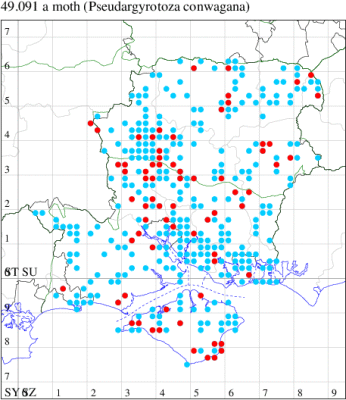
Records by year
Records by week (adult)
Records by week (larval)
Record Summary
VC10: Earliest: Bonchurch, 01 Jun, 1 (JHa) Latest: Wydcombe, 06 Sep, 1 (IOut) Max count: Totland, 24 Jun, 2 (RTer)
VC11: Earliest: Lee, nr Nursling, 28 May, 1 (CTha) Latest: Fareham, 08 Oct, 1 (MLO) Max count: Hilltop, The Hangers, 12 Jun, 25 (SIng)
VC12: Earliest: Chilbolton, 31 May, 1 (GCE) Latest: Harestock, 10 Sep, 1 (GRog) Max count: Shipton Bellinger, 26 Aug, 16 (BDal)
49.092 [B&F: 0921] Phtheochroa inopiana (Haworth, 1811) - Local
Local in dry pastures, fens and marshes, and on river-banks and other damp areas throughout England and Wales. Reasonably common in Hampshire, with the south-east quarter of the county responsible for more than two thirds of the total records on the county database, and with no indication of any significant decline in numbers, but very rare on the Isle of Wight. Wingspan 17-22 mm. The relatively large size of this species and the obscure markings and drab coloration of the forewing are characteristic [Bradley]. Larva feeds within roots of Common Fleabane and Field Wormwood, living within a silken tube or tent.
Records prior to 2021
| Vice County | #Records | #Individuals | First Record | Last Record |
|---|---|---|---|---|
| 10 | 116 | 232 | 1900 | 2020 |
| 11 | 609 | 1339 | 1971 | 2020 |
| 12 | 112 | 236 | 1987 | 2020 |
2021 records
| Vice County | #Records | #Individuals | Max Quantity |
|---|---|---|---|
| 10 | 22 | 27 | 2 |
| 11 | 12 | 12 | 1 |
| 12 | 2 | 3 | 2 |
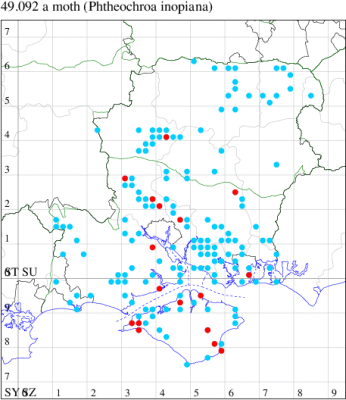
Records by year
Records by week (adult)
Records by week (larval)
Record Details
VC10: Totland, one, 21 Jul; one, 26 Jul; one, 28 Aug; one, 30 Aug (RTer); Freshwater Bay, one, 30 Jun; Freshwater, one, 29 Jun; two, 01 Jul; one, 08 Jul; one, 30 Jun (PBar); Parkhurst Forest, one, 13 Jul (TJN, IMer, LFom); Bonchurch, one, 12 Jul; one, 14 Jul (PBar); Haseley Manor, two, 13 Jul; two, 19 Jul; Shanklin, one, 29 Jun; two, 02 Jul; two, 07 Jul; one, 13 Jul; one, 14 Jul; one, 18 Jul; Osborne Valley Walk, one, 01 Jun; one, 22 Jul (IOut);
VC11: Marchwood, one, 07 Jul; one, 22 Jul (CTha); East Tytherley, one, 14 Jul (GCE); Romsey, one, 15 Jul (NRJ); Itchen Valley CP, one, 16 Jul (CTha); Barn Piece, Eastleigh, one, 26 Jun (KArb); Portsmouth, one, 01 Jul; one, 18 Jul (IRT); West Meon, one, 02 Jul; one, 02 Jul (RJD, MLO, ADT, DWal, KJW); Needs Ore NNR, one, 18 Aug (CNB); one, 19 Aug (PCra);
VC12: Barton Stacey, two, 16 Jul; one, 16 Jul (GCE)
49.094 [B&F: 0923] Phtheochroa sodaliana (Haworth, 1811) - Nationally Scarce B
Nationally scarce (Nb) in dry pastures, heathland and fens in parts of England and south-western Ireland. In Hampshire very local on the chalk around Winchester between the Itchen and Test valleys, also recorded historically from Oxenbourne Down, with wanderers elsewhere. Not recorded from the Isle of Wight to date. Wingspan 13-17 mm. In some respects reminiscent of a small P. rugosana but at once distinguished by the conspicuous ferruginous-red apical spot and the generally white basal area of the forewing; the dappled hindwing distinguishes this species from Hysterophora maculosana [Bradley]. Larva feeds within berries of Buckthorn.
Records prior to 2021
| Vice County | #Records | #Individuals | First Record | Last Record |
|---|---|---|---|---|
| 11 | 30 | 23 | 1964 | 2020 |
| 12 | 16 | 15 | 1991 | 2017 |
2021 records
| Vice County | #Records | #Individuals | Max Quantity |
|---|---|---|---|
| 12 | 1 | 1 | 1 |
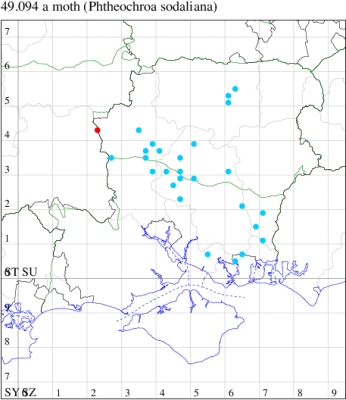
Records by year
Records by week (adult)
Records by week (larval)
Record Details
VC12: Cholderton, one, 02 Jul (TJN, LFom, HEdm)
49.095 [B&F: 0925] Phtheochroa rugosana (Hübner, [1799]) - Common
Common in hedgerows and open woodland throughout England. Locally common on the chalk in Hampshire, but remaining extremely scarce on the Isle of Wight, where it was reported for the first time in 30 years in 2022. Wingspan 16-20 mm. A distinctive species with a characteristic roughened texture and variegated pattern of the forewing [Bradley]. Larva feeds in berries and stems of White Bryony.
Records prior to 2021
| Vice County | #Records | #Individuals | First Record | Last Record |
|---|---|---|---|---|
| 10 | 1 | 1 | 1992 | 1992 |
| 11 | 213 | 255 | 1972 | 2020 |
| 12 | 181 | 236 | 1994 | 2020 |
2021 records
| Vice County | #Records | #Individuals | Max Quantity |
|---|---|---|---|
| 11 | 6 | 6 | 1 |
| 12 | 4 | 4 | 1 |
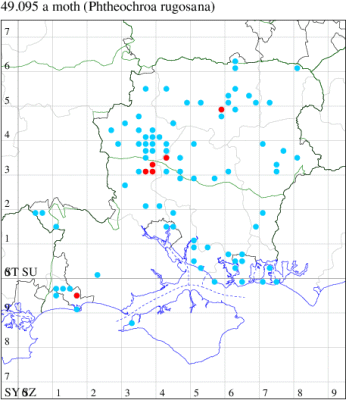
Records by year
Records by week (adult)
Records by week (larval)
Record Details
VC11: Ashley, one, 06 Jun; one, 06 Jun; Crawley, one, 28 Jun (GCE); Burton, nr Christchurch, one, 04 Jun; one, 11 Jun; one, 23 Jun (JStw);
VC12: Crawley, one, 31 May (GCE); Kempshott, one, 06 Jul; one, 10 Jul; one, 13 Jul (GAH)
49.097 [B&F: 0936] Cochylimorpha straminea (Haworth, 1811) - Common
Common in a wide range of habitats throughout the British Isles. In Hampshire and on the Isle of Wight widespread and rather common in localities where the foodplant occurs, mainly on the chalk and along the coast. Wingspan 13-21 mm. Large specimens with the markings well developed may resemble small C. alternana but may be recognised by the comparatively unmarked basal and terminal areas of the forewing and the absence of scale-tufts in the median fascia [Bradley]. Larva feeds within stems of Common Knapweed, living within the developing seeds.
Records prior to 2021
| Vice County | #Records | #Individuals | First Record | Last Record |
|---|---|---|---|---|
| 10 | 43 | 69 | 1856 | 2020 |
| 11 | 418 | 532 | 1971 | 2020 |
| 12 | 227 | 350 | 1988 | 2020 |
2021 records
| Vice County | #Records | #Individuals | Max Quantity |
|---|---|---|---|
| 10 | 5 | 6 | 2 |
| 11 | 45 | 56 | 3 |
| 12 | 16 | 20 | 5 |
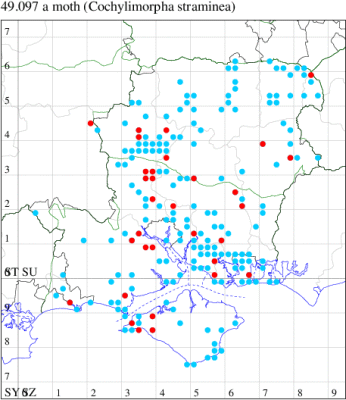
Records by year
Records by week (adult)
Records by week (larval)
Record Details
VC10: Totland, one, 26 Jun; one, 01 Sep (RTer); Freshwater Bay, one, 02 Jun (SDav); Brook Down, two, field observation, 05 Jun (DCoo); Cranmore, one, 30 Aug (CHic);
VC11: Marchwood, one, 16 Jun (TDCh); one, 04 Sep (CTha); Woodlands, NF, present, 04 Sep (RBW); Totton, one, field observation, 17 Jun; one, 20 Aug; one, 21 Aug; one, 22 Aug; two, 23 Aug; three, 24 Aug; two, 25 Aug; one, 26 Aug; one, 29 Aug; one, 30 Aug; one, 31 Aug; one, 01 Sep; one, 06 Sep; one, 07 Sep (LHan); Kings Somborne, one, 09 Jun (GCE); Romsey, one, 26 Aug (NRJ); Kings Somborne, one, 09 Jun; Ashley, one, 20 Aug; two, 20 Aug; two, 04 Sep; one, 20 Aug (GCE); Allbrook, one, 21 Aug; one, 25 Aug; one, 04 Sep (SIng); Lee-on-Solent, one, 01 Sep (IHrg); Fareham, one, 25 Aug (ADT); Botley, one, 20 Aug; one, 31 Aug; one, 25 Aug (SLB); Wickham Common, three, 28 May (KCok, RJD, MLO, DWal); Portsmouth, one, 02 Jun; one, 14 Jun; one, 16 Jun; one, 06 Sep (IRT); West Meon, one, 03 Sep; two, 03 Sep; one, 03 Sep; Old Winchester Hill, two, 11 Jun; two, 11 Jun (RJD, MLO, DWal, KJW); Tuckton, Christchurch, one, 12 Jun (APar); Pennington, one, 23 Apr; two, 13 Aug (RFC);
VC12: Shipton Bellinger, one, field observation, 26 Aug (BDal); Anna Valley, Andover, one, 14 Aug; one, 01 Sep (TJN, LFom); Goodworth Clatford, five, 30 Aug; one, 30 Aug; one, 30 Aug; one, 30 Aug; one, 30 Aug; Crawley, one, 25 Aug; Barton Stacey, one, 29 Aug; one, 29 Aug (GCE); Morn Hill, Winchester, one, 27 Aug (MJW, DAS, PDF); Alton, one, 29 Aug (BCA); Whitehill, one, 01 Jun; one, 20 Aug (ASto); Blackwater, one, 22 Aug (BDal)
49.101 [B&F: 0926] Phalonidia manniana (Fischer von Röslerstamm, 1839) - Local
Local in marshes, river-banks and other freshwater margins, predominately in southern England, but also in north Wales eastwards to Yorkshire. In Hampshire mainly restricted to coastal sites such as Lower Test Marsh and Titchfield Haven, inland there are records from Botley Wood and Winnall Moors, Winchester, but it is very rare elsewhere, and there are no recent records from the Isle of Wight. Wingspan 10-13 mm. Larva feeds within stems of Water Mint and Gypsywort.
Records prior to 2021
| Vice County | #Records | #Individuals | First Record | Last Record |
|---|---|---|---|---|
| 10 | 11 | 25 | 1900 | 2019 |
| 11 | 81 | 106 | 1992 | 2020 |
| 12 | 49 | 59 | 1987 | 2020 |
2021 records
| Vice County | #Records | #Individuals | Max Quantity |
|---|---|---|---|
| 10 | 1 | 24 | 24 |
| 11 | 2 | 2 | 1 |
| 12 | 2 | 3 | 2 |
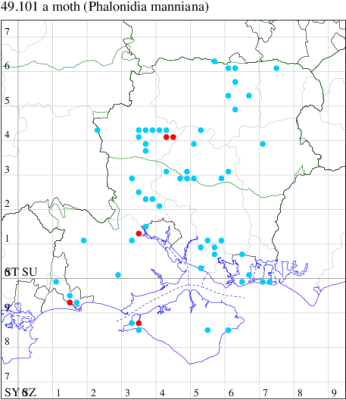
Records by year
Records by week (adult)
Records by week (larval)
Record Details
VC10: Afton Marsh, 24, gen det, 03 Jul (PBar);
VC11: Totton, one, 19 Jul (LHan); Tuckton, Christchurch, one, 24 Jun (APar);
VC12: Barton Stacey, two, 16 Jul; Bullington, one, 16 Jul (GCE)
49.103 [B&F: 0932] Phalonidia affinitana (Douglas, 1846) - Local
Local in saltmarshes throughout much of England, Wales and Ireland, predominantly coastal. In Hampshire locally common in salt-marshes, from Hurst Castle to Sandy Point, with a few inland records in the south. Under-recorded in the Isle of Wight, but recent years have seen reports from Newtown, Freshwater and Norton Spit. Wingspan 13-16 mm. Distinguished from other species of Phalonidia and from species of Gynnidomorpha by the median fascia being strongly developed in the dorsal half of the wing and obsolescent costally [Bradley]. Larva feeds within flowerheads of Sea Aster.
Records prior to 2021
| Vice County | #Records | #Individuals | First Record | Last Record |
|---|---|---|---|---|
| 10 | 14 | 63 | 1850 | 2018 |
| 11 | 33 | 37 | 1974 | 2019 |
2021 records
| Vice County | #Records | #Individuals | Max Quantity |
|---|---|---|---|
| 10 | 1 | 1 | 1 |
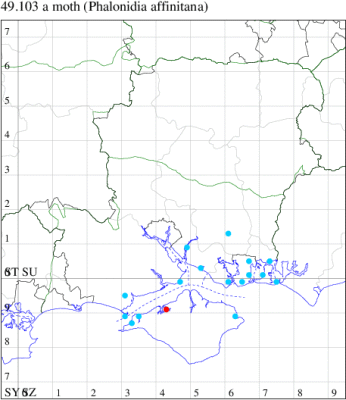
Records by year
Records by week (adult)
Records by week (larval)
Record Details
VC10: Newtown Creek, one, field observation, 11 Aug (DCoo)
49.104 [B&F: 0931] Gynnidomorpha luridana (Gregson, 1870) - Nationally Scarce A
Nationally scarce (Na) on dry pastures, farmland and downland in northern and southern counties of England, but absent from much of central England. In Hampshire an uncommon species, found mainly on the chalk around Winchester, with records south to the New Forest and north to Basingstoke. Not recorded from the Isle of Wight to date. Wingspan 11-13 mm. Larva feeds on Scented Mayweed, Red Bartsia and Eyebright.
Records prior to 2021
| Vice County | #Records | #Individuals | First Record | Last Record |
|---|---|---|---|---|
| 10 | 1 | 1 | 2016 | 2016 |
| 11 | 19 | 31 | 1977 | 2020 |
| 12 | 44 | 57 | 1994 | 2020 |
2021 records
| Vice County | #Records | #Individuals | Max Quantity |
|---|---|---|---|
| 11 | 3 | 4 | 2 |
| 12 | 2 | 2 | 1 |
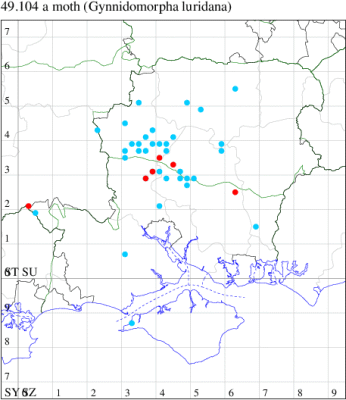
Records by year
Records by week (adult)
Records by week (larval)
Record Details
VC11: Ashley*, one, 24 Jul; two, 24 Jul (GCE); West Meon, one, gen det, 02 Jul (RJD, MLO, ADT, DWal, KJW det. RJD);
VC12: Crawley, one, 12 Jul; one, 13 Jul (GCE)
49.105 [B&F: 0929] Gynnidomorpha vectisana (Humphreys & Westwood, 1845) - Local
Local in saltmarshes, fens, wet heathland and freshwater marshes throughout much of England, Wales and southern Ireland. In Hampshire and on the Isle of Wight predominantly a species of coastal salt-marshes, and locally common in the south of the county and along the north coast of the Island. Wingspan 9-12 mm. Although extremely variable in wing pattern, the small size of this species and the olive-brown general coloration of the forewing and the reticulation in the distal area are characteristic [Bradley]. Larva feeds within stems of Sea Arrowgrass and Marsh Arrowgrass.
Records prior to 2021
| Vice County | #Records | #Individuals | First Record | Last Record |
|---|---|---|---|---|
| 10 | 18 | 8 | 1856 | 2014 |
| 11 | 19 | 72 | 1974 | 2011 |
2021 records
| Vice County | #Records | #Individuals | Max Quantity |
|---|---|---|---|
| 11 | 2 | 3 | 2 |
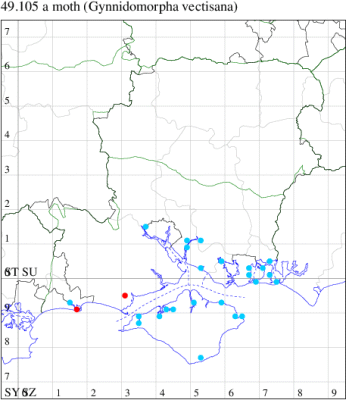
Records by year
Records by week (adult)
Records by week (larval)
Record Details
VC11: Hengistbury Head, two, 11 Aug (MJef)
49.108 [B&F: 0930] Gynnidomorpha alismana (Ragonot, 1883) - Nationally Scarce B
Nationally scarce (Nb) in streams, small rivers and shallow pools in parts of Britain and southern Ireland. In Hampshire formerly common at three locations in the south, but after one at Titchfield Haven in 1978 not recorded until 2004, when one came to light in Southsea. Not recorded from the Isle of Wight since 1934. Wingspan 11-14 mm. Similar to G. minimana but distinguished by the less angulate median fascia of the forewing and the pre-apical spot which is usually strigulate or fractured in the tornal area [Bradley]. Larva feeds within flowering shoots of Water-plantain.
Records prior to 2021
| Vice County | #Records | #Individuals | First Record | Last Record |
|---|---|---|---|---|
| 10 | 1 | 1 | 1934 | 1934 |
| 11 | 3 | 3 | 1978 | 2017 |
2021 records
| Vice County | #Records | #Individuals | Max Quantity |
|---|---|---|---|
| 11 | 1 | 1 | 1 |
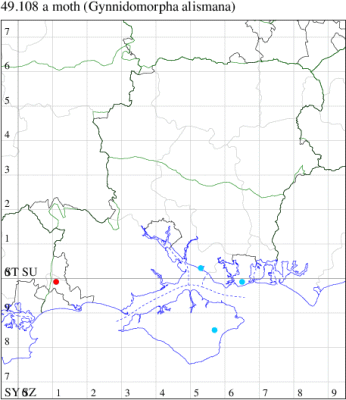
Records by year
Records by week (adult)
Records by week (larval)
Record Details
VC11: Merritown Heath, one, 10 Jun (DFoo)
49.109 [B&F: 0937] Agapeta hamana (Linnaeus, 1758) - Common
Common in rough meadows and on waste ground throughout the British Isles. In Hampshire and on the Isle of Wight widespread and often abundant in rough grassland, especially on the chalk and amongst thistles. Wingspan 17-24 mm. This species is readily distinguished by the pale yellow ground coloration and the reduced, ferruginous-brown markings of the forewing [Bradley]. Larva feeds within roots of various species of thistle.
Records prior to 2021
| Vice County | #Records | #Individuals | First Record | Last Record |
|---|---|---|---|---|
| 10 | 393 | 664 | 1856 | 2020 |
| 11 | 2224 | 3675 | 1971 | 2020 |
| 12 | 1648 | 3884 | 1971 | 2020 |
2021 records
| Vice County | #Records | #Individuals | Max Quantity |
|---|---|---|---|
| 10 | 57 | 88 | 4 |
| 11 | 101 | 204 | 15 |
| 12 | 83 | 112 | 5 |
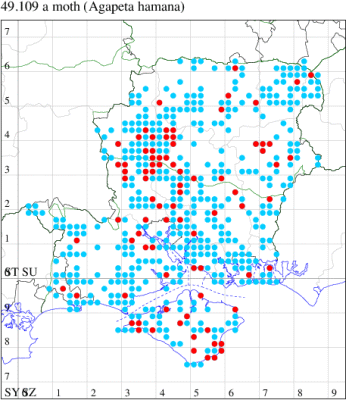
Records by year
Records by week (adult)
Records by week (larval)
Record Summary
VC10: Earliest: Freshwater, 09 Jun, 1 (DCoo) Latest: Totland, 04 Sep, 1 (RTer) Max count: Freshwater, 03 Jul, 4 (PBar)
VC11: Earliest: Winter Down Copse, Little Somborne, 02 Jun, 1 (GCE) Latest: West Meon, 03 Sep, 1 (RJD, MLO, DWal, KJW) Max count: Broughton, 25 Jul, 15 (GCE)
VC12: Earliest: Beech, 28 May, 1 (NDP) Latest: Barton Stacey, 02 Sep, 1 (GCE) Max count: Crawley, 14 Jun, 5 (GCE)
49.110 [B&F: 0938] Agapeta zoegana (Linnaeus, 1767) - Common
Common in dry pastures, downland, scrub and waste ground throughout much of the British Isles, less numerous in the north. In Hampshire and on the Isle of Wight widespread but considerably more local and generally less common than the closely related A. hamana. Wingspan 15-24 mm. A distinctive species readily recognised by the bright yellow coloration and characteristic pattern of the forewing [Bradley]. Larva feeds within roots of Common Knapweed and Small Scabious.
Records prior to 2021
| Vice County | #Records | #Individuals | First Record | Last Record |
|---|---|---|---|---|
| 10 | 104 | 200 | 1880 | 2020 |
| 11 | 399 | 782 | 1965 | 2020 |
| 12 | 322 | 751 | 1976 | 2020 |
2021 records
| Vice County | #Records | #Individuals | Max Quantity |
|---|---|---|---|
| 10 | 16 | 21 | 3 |
| 11 | 12 | 16 | 3 |
| 12 | 12 | 24 | 11 |
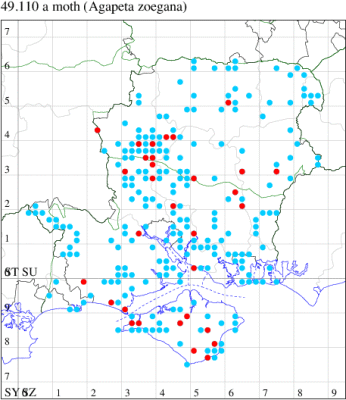
Records by year
Records by week (adult)
Records by week (larval)
Record Details
VC10: Freshwater, one, 07 Jul (DCoo); one, 29 Jun; two, 07 Jul (PBar); Plaish, Carisbrooke, one, 24 Jul; two, 25 Jul (KRyl); Newport, one, 29 Jun; one, 29 Jul; one, 30 Jul; one, 03 Aug (DPl); Wydcombe, one, to light, 08 Jul (JRB, IOut); Rew Down, Ventnor, one, 11 Jul; two, 11 Jul; three, 15 Jul (PBar); Haseley Manor, one, 19 Jul; Shanklin, one, 07 Jul; one, 20 Jul (IOut);
VC11: Totton, one, 29 Jun (LHan); Kings Somborne, one, 29 Jun; Broughton, one, 25 Jul; Winter Down Copse, Little Somborne, one, 30 Jun (GCE); Allbrook, one, 31 Jul (SIng); Brownwich cliffs, one, 16 Jul (MLO, RJD, KJW); Botley, one, 25 Jul (SLB); West Meon, three, 02 Jul (RJD, MLO, ADT, DWal, KJW); Old Winchester Hill, one, vacuum sampling, 05 Jul (MCha det. RJD); Avon Tyrell, one, to artificial light, 07 Aug (RBas); Milford on Sea, two, 15 Jul; Keyhaven, two, 15 Aug (MMcM);
VC12: Cholderton, one, 02 Jul (TJN, LFom, HEdm); Goodworth Clatford, three, 30 Aug (GCE); Stockbridge Down, one, 10 Aug (JMor); one, field observation, 03 Jul (CKni); Chilbolton, one, 27 Jul; Crawley, one, 28 Jun; Barton Stacey, one, 16 Jul; one, 01 Aug (GCE); Morn Hill, Winchester, 11, 17 Jul (CBey, DAS, PDF); Ropley, one, 12 Aug (TJN, LFom); Basingstoke, one, 14 Jun (RHil); Noar Hill, Selborne, one, seen by day, on low vegetation, 16 Aug (RJD)
49.111 [B&F: 0954] Eupoecilia angustana (Hübner, [1799]) - Common
Common on woodland edges, mountains and heathland throughout the British Isles. Widespread and common in Hampshire but still scarce on the Isle of Wight. Wingspan 11-15 mm. Apart from the somewhat confusing Shetland and Orkney subspecies, most closely resembles Vine Moth E. ambiguella, from which distinguished by the narrower and relatively diffuse median fascia of the forewing and the presence of a terminal fascia [Bradley]. Larva feeds within flowers of Greater Plantain, Ribwort Plantain, Yarrow and Heather.
Records prior to 2021
| Vice County | #Records | #Individuals | First Record | Last Record |
|---|---|---|---|---|
| 10 | 35 | 41 | 1893 | 2020 |
| 11 | 266 | 391 | 1971 | 2020 |
| 12 | 96 | 133 | 1971 | 2020 |
2021 records
| Vice County | #Records | #Individuals | Max Quantity |
|---|---|---|---|
| 11 | 5 | 8 | 3 |
| 12 | 5 | 5 | 1 |
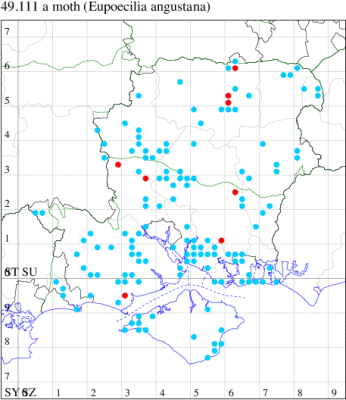
Records by year
Records by week (adult)
Records by week (larval)
Record Details
VC11: Broughton Down, one, 12 Jun (MBot); Ashley, two, 26 Jun (GCE); Wickham Common, one, 28 May (KCok, RJD, MLO, DWal); West Meon, three, gen det, 02 Jul (RJD, MLO, ADT, DWal, KJW det. RJD); Pennington, one, 14 Jun (RFC);
VC12: Basingstoke, one, 06 Sep; one, 09 Sep; one, 26 Sep (MJW); one, 14 Jul (RHil); Pamber Forest, one, 16 Jun (GJD)
49.112 [B&F: 0955] Vine Moth Eupoecilia ambiguella (Hübner, 1796) - Nationally Scarce B
Nationally scarce (Nb) on heathland and woodland in parts of southern England. In Hampshire very local in the New Forest and Emer Bog in the south, and discovered in 1987 on Newtown Common in the north. On the Isle of Wight, recorded from a few sites in the far west. A distinctive species, readily recognised by the pale ochreous general coloration of the forewing and the contrasting heavy median fascia [Bradley]. Larva feeds within flowers of Alder Buckthorn, Honeysuckle and Grape-vine, causing sufficient damage to be a serious pest in vineyards in some areas, over-wintering in a case made from leaf fragments.
Records prior to 2021
| Vice County | #Records | #Individuals | First Record | Last Record |
|---|---|---|---|---|
| 10 | 6 | 6 | 1997 | 2020 |
| 11 | 25 | 26 | 1985 | 2020 |
| 12 | 3 | 1 | 1987 | 2011 |
2021 records
| Vice County | #Records | #Individuals | Max Quantity |
|---|---|---|---|
| 11 | 3 | 3 | 1 |
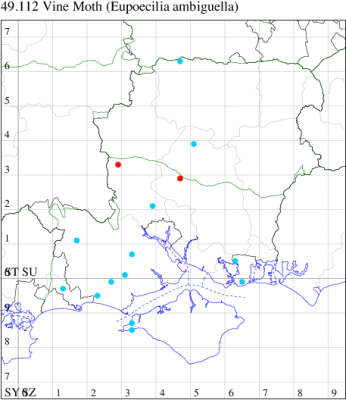
Records by year
Records by week (adult)
Records by week (larval)
Record Details
VC11: Broughton Down, one, 12 Jun (MBot); Winchester, one, 25 Jul; one, 30 Jul (THW)
49.120 [B&F: 0947] Aethes smeathmanniana (Fabricius, 1781) - Common
Common in waste ground, shingle beaches and chalk downland throughout much of Britain. In Hampshire widespread and common but probably under-recorded, the extent of known records correlating with those areas in which the recording effort is concentrated. On the Isle of Wight, seemingly rather uncommon. Wingspan 12-17 mm. Readily distinguished from A. cnicana and A. rubigana by the narrower and more elongate forewing and the narrower median fascia which is more outward-oblique from the dorsum; in general appearance it somewhat resembles Cochylimorpha straminea but is distinguished by the presence of the well-developed fasciate pre-tornal marking [Bradley]. Larva feeds within seedheads of Yarrow and Common Knapweed.
Records prior to 2021
| Vice County | #Records | #Individuals | First Record | Last Record |
|---|---|---|---|---|
| 10 | 16 | 16 | 1850 | 2020 |
| 11 | 541 | 723 | 1971 | 2020 |
| 12 | 146 | 175 | 1992 | 2020 |
2021 records
| Vice County | #Records | #Individuals | Max Quantity |
|---|---|---|---|
| 10 | 2 | 2 | 1 |
| 11 | 29 | 31 | 4 |
| 12 | 4 | 4 | 1 |
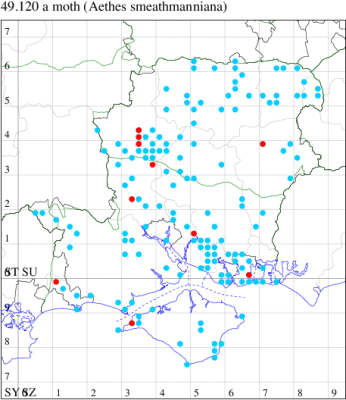
Records by year
Records by week (adult)
Records by week (larval)
Record Details
VC10: Totland, one, 28 Aug; one, 31 Aug (RTer);
VC11: Winter Down Copse, Little Somborne, one, 02 Jun; Crawley, one, 15 May (GCE); #N/ABotley, one, 31 May; four, 02 Jun; one, 12 Jun; one, 09 Aug; one, 21 Aug; one, 28 May; one, 02 Jun; two, 03 Jun; one, 09 Jun; one, 11 Jun; one, 13 Jun; one, 16 Jun; one, 25 Jul; one, 26 Jul; one, 31 Jul; one, 01 Aug; one, 04 Aug; one, 21 Aug; one, 09 Sep (SLB); Portsmouth, one, 12 Jun; one, 14 Jun; one, 15 Jun; one, 03 Sep; one, 06 Sep (IRT); Merritown Heath, present, 28 May; present, 10 Jun (DFoo);
VC12: Goodworth Clatford, one, 30 Aug (GCE); Anna Valley, Andover, one, 06 Sep (TJN, LFom); Wherwell: SU3440: Westover Farm: S of Flint Farm, one, 30 Aug (GCE); Alton, one, 17 Aug (DBO)
49.121 [B&F: 0939] Aethes tesserana ([Denis & Schiffermüller], 1775) - Local
Local in a wide range of habitats throughout much of southern England, with records north to Yorkshire. In Hampshire and on the Isle of Wight it seems to prefer xerothermic conditions such as dry, close-cropped chalk downland and coastal shingle, and largely absent from the New Forest and northern half of the county. Wingspan 12-17 mm. The bold chequered pattern formed by the markings and contrasting ground colour of the forewing are characteristic [Bradley]. Larva feeds within roots of Ploughman's-spikenard, Bristly Oxtongue and Hawkweed Oxtongue.
Records prior to 2021
| Vice County | #Records | #Individuals | First Record | Last Record |
|---|---|---|---|---|
| 10 | 37 | 104 | 1856 | 2020 |
| 11 | 23 | 34 | 1974 | 2017 |
| 12 | 5 | 4 | 1971 | 2020 |
2021 records
| Vice County | #Records | #Individuals | Max Quantity |
|---|---|---|---|
| 10 | 2 | 4 | 3 |
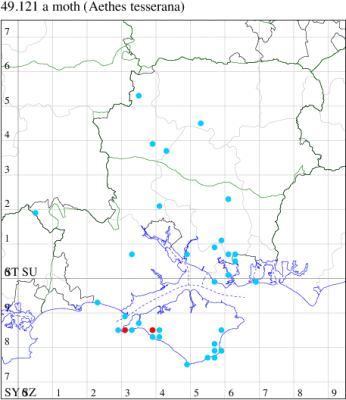
Records by year
Records by week (adult)
Records by week (larval)
Record Details
VC10: High Down: Main Bench, three, field observation, 28 Jun (PBar); Brook Down, one, field observation, 05 Jun (DCoo)
49.123 [B&F: 0951] Aethes beatricella (Walsingham, 1898) - Local
Local on waste ground, in woodland edges and hedgerows throughout much of England and Wales. In Hampshire infrequently recorded and nowhere common, but has been recorded several times from Southsea; first recorded from the Isle of Wight in 2015. Wingspan 14-17 mm. Distinguished from A. francillana by the broader and less oblique median and postmedian fasciae of the forewing [Bradley]. Larva feeds within stems of Hemlock.
Records prior to 2021
| Vice County | #Records | #Individuals | First Record | Last Record |
|---|---|---|---|---|
| 10 | 10 | 14 | 2015 | 2020 |
| 11 | 28 | 23 | 1982 | 2020 |
| 12 | 17 | 17 | 1996 | 2020 |
2021 records
| Vice County | #Records | #Individuals | Max Quantity |
|---|---|---|---|
| 10 | 2 | 2 | 1 |
| 11 | 3 | 3 | 1 |
| 12 | 1 | 1 | 1 |
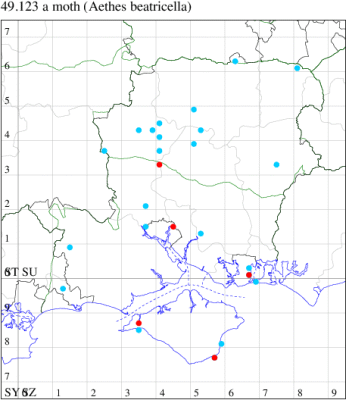
Records by year
Records by week (adult)
Records by week (larval)
Record Details
VC10: Freshwater, one, gen det, 30 Jun (PBar); Wheelers Bay, one, 14 Jun (ABut);
VC11: Southampton, one, 23 Jun (MGP); Portsmouth, one, gen det, 15 Jun; one, gen det, 16 Jun (IRT);
VC12: Crawley, one, 28 Jun (GCE)
49.124 [B&F: 0950] Aethes francillana (Fabricius, 1794) - Local
Local in dry pastures, downland and waste ground throughout much of the British Isles, predominantly coastal in the north of its range. In Hampshire largely absent from the New Forest and uncommon in the north, but fairly widely distributed in the south-east and along the chalk. On the Isle of Wight, there are no recent records, but it has occurred in the past. Wingspan 13-18 mm. Differs from A. dilucidana in having the median fascia of the forewing complete; compared with A. beatricella the median and postmedian fasciae are narrower and more oblique, the costal end of the median fascia extending beyond the dorsal end of the postmedian [Bradley]. Larva feeds on seeds of Wild Carrot, living between flower heads spun together with silk.
Records prior to 2021
| Vice County | #Records | #Individuals | First Record | Last Record |
|---|---|---|---|---|
| 10 | 22 | 19 | 1856 | 2020 |
| 11 | 79 | 84 | 1964 | 2020 |
| 12 | 10 | 8 | 1996 | 2012 |
2021 records
| Vice County | #Records | #Individuals | Max Quantity |
|---|---|---|---|
| 11 | 3 | 3 | 1 |
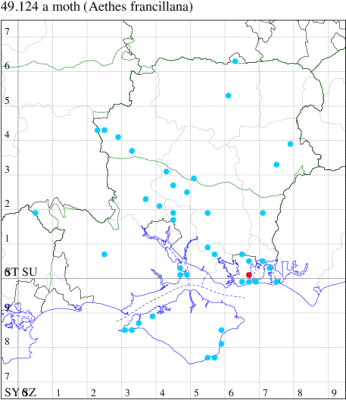
Records by year
Records by week (adult)
Records by week (larval)
Record Details
VC11: Portsmouth, one, 18 Jul; one, 19 Jul; one, 11 Aug (IRT)
49.127 [B&F: 0945] Aethes cnicana (Westwood, 1854) - Common
Common in rough grassland, waste ground and damp woodland edges throughout the British Isles. In Hampshire and on the Isle of Wight reasonably well-distributed, with a significant population in Botley Wood. Wingspan 14-17 mm. Very similar to A. rubigana, but differing in the slightly smaller size and the comparatively narrow, less oblique and usually uninterrupted median fascia of the forewing [Bradley]. Larva feeds within seeds of various species of thistle, especially Spear Thistle and Marsh Thistle.
Records prior to 2021
| Vice County | #Records | #Individuals | First Record | Last Record |
|---|---|---|---|---|
| 10 | 29 | 33 | 1900 | 2020 |
| 11 | 136 | 173 | 1973 | 2019 |
| 12 | 74 | 94 | 1971 | 2020 |
2021 records
| Vice County | #Records | #Individuals | Max Quantity |
|---|---|---|---|
| 11 | 7 | 9 | 2 |
| 12 | 2 | 2 | 1 |
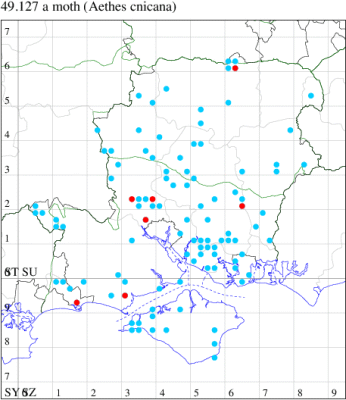
Records by year
Records by week (adult)
Records by week (larval)
Record Details
VC11: Lee, nr Nursling, two, 30 May (CTha); Romsey, one, 26 Jun (NRJ); Stanbrige Earls, one, 28 May; two, 01 Jun (JRM); Old Winchester Hill, one, 11 Jun (RJD, MLO, DWal, KJW det. RJD); Stanpit Marsh LNR, one, 04 Jul (PAB); Pennington, one, 28 May (RFC);
VC12: Pamber Forest, one, 11 Jun; one, 16 Jun (GJD)
49.128 [B&F: 0946] Aethes rubigana (Treitschke, 1830) - Common
Common on waste ground and dry open areas throughout the British Isles. In our area reasonably well-distributed, including the Isle of Wight in recent years. Wingspan 15-19 mm. Distinguished from A. cnicana by its usually larger size and the broader, more oblique and almost invariably clearly interrupted, median fascia of the forewing [Bradley]. Larva feeds within seedheads of Greater and Lesser Burdock.
Records prior to 2021
| Vice County | #Records | #Individuals | First Record | Last Record |
|---|---|---|---|---|
| 10 | 73 | 127 | 1880 | 2020 |
| 11 | 137 | 149 | 1977 | 2020 |
| 12 | 135 | 163 | 1993 | 2020 |
2021 records
| Vice County | #Records | #Individuals | Max Quantity |
|---|---|---|---|
| 10 | 2 | 2 | 1 |
| 11 | 12 | 13 | 2 |
| 12 | 3 | 4 | 2 |
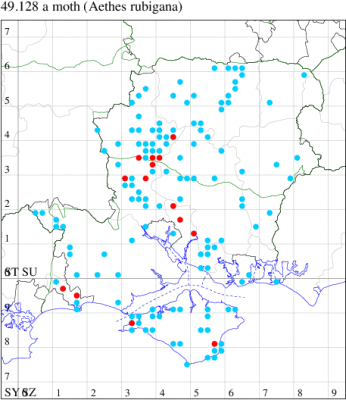
Records by year
Records by week (adult)
Records by week (larval)
Record Details
VC10: Totland, one, 22 Jul (RTer); Shanklin, one, 17 Jul (IOut);
VC11: East Tytherley, one, 12 Jun; Ashley, one, 24 Jul; Kings Somborne, one, 18 Jul; Winter Down Copse, Little Somborne, one, 30 Jun; one, 19 Jul (GCE); Itchen Valley CP, one, 16 Jul (CTha); Allbrook, one, 18 Jul (SIng); Botley, one, 19 Jul (SLB); Wickham, one, 17 Jul (JRDS); Hurn, one, 29 Jun; two, 02 Jul (MJef); Burton, nr Christchurch, one, 22 Jul (JStw);
VC12: Crawley, one, 17 Jul; two, 17 Jul; Bullington, one, 16 Jul (GCE)
49.129 [B&F: 0959] Cochylidia rupicola (Curtis, 1834) - Local
Local in woodland, downland, marshes, river-banks and ditches throughout much of England and southern Ireland, predominantly coastal in the north of its range. In Hampshire and on the Isle of Wight distinctly uncommon, with records restricted to those locations where the recording effort is concentrated: Botley Wood, Leckford, Fareham, Portsmouth and, on the Island, Ventnor. Wingspan 12-14 mm. The comparatively broad forewing and the rounded apex are rather characteristic of this species. Distinguished from C. subroseana by the broader median fascia and the well-developed postmedian and subapical markings [Bradley]. Larva feeds on flowers and seeds of Hemp-agrimony, over-wintering in a cocoon.
Records prior to 2021
| Vice County | #Records | #Individuals | First Record | Last Record |
|---|---|---|---|---|
| 10 | 10 | 12 | 1880 | 2010 |
| 11 | 23 | 29 | 2000 | 2019 |
| 12 | 8 | 5 | 1977 | 2011 |
2021 records
| Vice County | #Records | #Individuals | Max Quantity |
|---|---|---|---|
| 10 | 1 | 1 | 1 |
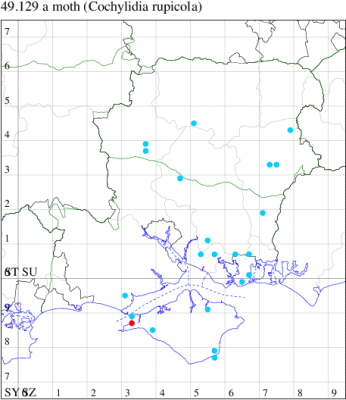
Records by year
Records by week (adult)
Records by week (larval)
Record Details
VC10: Totland, one, field observation, netted from Hemp Agrimony, 31 Jul (RTer)
49.132 [B&F: 0956] Cochylidia implicitana (Wocke, 1856) - Local
Local on waste ground throughout much of southern England, north to Lancashire. In Hampshire an elusive, uncommon species, with scattered records mainly concentrated in North Hampshire and the south-east. Rarely encountered elsewhere, including the New Forest and the Isle of Wight. Wingspan 10-14 mm. Slightly larger than C. heydeniana, and usually readily distinguished by the presence of a weak pinkish flush to the forewing and the relatively slender median fascia; similar to forms of Falseuncaria degreyana, which lack the pink flush to the forewing, but which are readily recognised by the conspicuous line in the cilia [Bradley]. Larva feeds on flowers of Scented Mayweed, Sea Mayweed, Stinking Chamomile and Goldenrod, over-wintering in a cocoon.
Records prior to 2021
| Vice County | #Records | #Individuals | First Record | Last Record |
|---|---|---|---|---|
| 10 | 5 | 3 | 1850 | 2020 |
| 11 | 100 | 108 | 1971 | 2020 |
| 12 | 41 | 43 | 1993 | 2020 |
2021 records
| Vice County | #Records | #Individuals | Max Quantity |
|---|---|---|---|
| 10 | 2 | 5 | 4 |
| 11 | 8 | 8 | 1 |
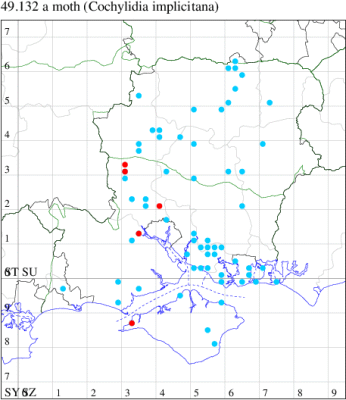
Records by year
Records by week (adult)
Records by week (larval)
Record Details
VC10: Totland, one, 03 Sep (RTer); Freshwater, four, 03 Sep (DCoo);
VC11: Totton, one, 12 Aug; one, 13 Aug; one, 15 Aug; one, 17 Aug (LHan); Broughton, one, 06 Sep; one, 08 Jul; one, 06 Sep (GCE); Chandlers Ford, one, 21 Aug (BEll)
49.133 [B&F: 0968] Thyraylia nana (Haworth, 1811) - Common
Common in birch woodland and on heathland throughout much of Britain. Frequent in Hampshire, but only one old record from the Isle of Wight. Wingspan 9-12 mm. A distinctive species, at once recognised by its small size and characteristic grey and ochreous general coloration, and the broad median fascia of the forewing with its outer margin outward-oblique from the costa and the inner margin diffuse and often confluent with the ill-defined basal fasciae [Bradley]. Larva feeds within catkins of Downy Birch and Silver Birch, over-wintering in a cocoon.
Records prior to 2021
| Vice County | #Records | #Individuals | First Record | Last Record |
|---|---|---|---|---|
| 10 | 3 | 2 | 1900 | 2017 |
| 11 | 126 | 139 | 1975 | 2020 |
| 12 | 50 | 60 | 1976 | 2020 |
2021 records
| Vice County | #Records | #Individuals | Max Quantity |
|---|---|---|---|
| 11 | 6 | 5 | 2 |
| 12 | 5 | 6 | 2 |
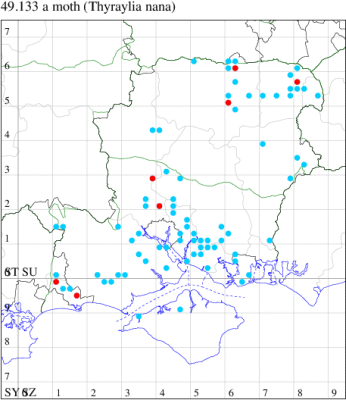
Records by year
Records by week (adult)
Records by week (larval)
Record Details
VC11: Kings Somborne, two, 09 Jun (GCE); Barn Piece, Eastleigh, one, 05 Jun (KArb); Merritown Heath, present, 28 May; present, 10 Jun (DFoo); Burton, nr Christchurch, one, 04 Jun; one, 09 Jun (JStw);
VC12: Basingstoke, one, 12 Jun (RHil); Pamber Forest, one, 02 Jun; two, 16 Jun; one, 16 Jul (GJD); Minley Wood, one, field observation, 14 Jun (BDal)
49.134 [B&F: 0962] Cochylis roseana (Haworth, 1811) - Local
Local in rough ground throughout much of southern England, with records north to Cheshire. Under-recorded in Hampshire and on the Isle of Wight, where the extent of known records correlate with those areas in which the recording effort is concentrated, and probably present wherever the foodplants occurs regularly. Wingspan 10-17 mm. Distinguished from C. flaviciliana by the darker median fascia of the forewing and the presence of a subapical line in the cilia; the presence of the subapical line also separates this species from Falseuncaria degreyana [Bradley]. Larva feeds within seedheads of Wild Teasel.
Records prior to 2021
| Vice County | #Records | #Individuals | First Record | Last Record |
|---|---|---|---|---|
| 10 | 45 | 83 | 1856 | 2020 |
| 11 | 70 | 158 | 1974 | 2020 |
| 12 | 19 | 17 | 1993 | 2018 |
2021 records
| Vice County | #Records | #Individuals | Max Quantity |
|---|---|---|---|
| 10 | 1 | 1 | 1 |
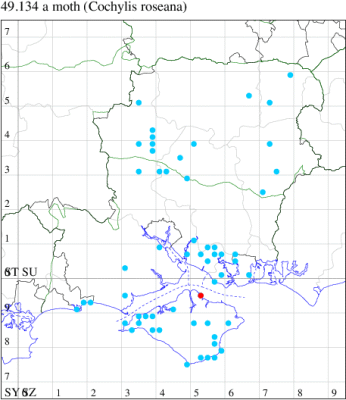
Records by year
Records by week (adult)
Records by week (larval)
Record Details
VC10: Osborne Valley Walk, one, 26 Aug (IOut)
49.136 [B&F: 0965] Neocochylis hybridella (Hübner, [1813]) - Local
Local on chalk downland, woodland on chalky soils and sand-dunes throughout much of southern England and southern Wales, with records north to Cheshire. In Hampshire and on the Isle of Wight taken occasionally at light, mostly in a band from Romsey in the west to Southsea in the east, perhaps overlooked elsewhere. Wingspan 12-16 mm. Distinguished from C. dubitana and C. atricapitana by the white thorax [Bradley]. Larva feeds within seedheads of Bristly Oxtongue, Hawkweed Oxtongue, several species of Hawk's-beard, over-wintering in a cocoon.
Records prior to 2021
| Vice County | #Records | #Individuals | First Record | Last Record |
|---|---|---|---|---|
| 10 | 30 | 32 | 1856 | 2020 |
| 11 | 130 | 137 | 1994 | 2020 |
| 12 | 26 | 31 | 1995 | 2020 |
2021 records
| Vice County | #Records | #Individuals | Max Quantity |
|---|---|---|---|
| 10 | 8 | 13 | 4 |
| 11 | 10 | 10 | 1 |
| 12 | 2 | 6 | 4 |
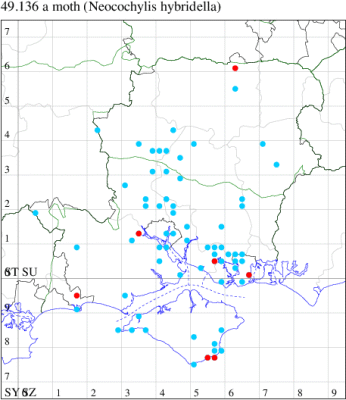
Records by year
Records by week (adult)
Records by week (larval)
Record Details
VC10: Rew Down, Ventnor, one, 11 Jul; two, gen det, 15 Jul; two, gen det, 13 Jul (PBar); Wheelers Bay, one, 03 Jun; one, 04 Aug; one, 01 Sep; four, 06 Sep; one, 07 Sep (ABut);
VC11: Totton, one, 30 Jun; one, 01 Jul; one, 08 Jul; one, 10 Aug; one, 27 Aug; one, 28 Aug (LHan); Fareham, one, 01 Jul (IMcP); Portsmouth, one, 17 Jul; one, 18 Jul (IRT); Burton, nr Christchurch, one, 03 Sep (JStw);
VC12: Pamber Forest, two, 11 Jun; four, 16 Jun (GJD)
49.137 [B&F: 0964] Neocochylis dubitana (Hübner, [1799]) - Common
Common on dry pastures and waste ground throughout southern England and southern Wales, north to Yorkshire. In Hampshire the species is widely distributed, but not particularly common. Recorded on the Isle of Wight for the first time since 1900 at Freshwater in 2010. Wingspan 11-16 mm. Similar to C. atricapitana, in which the head and labial palpus are blackish grey, and C. hybridella, in which the thorax is white (blackish in C. dubitana). Larva feeds within flowers of Common Ragwort, Rough Hawk's-beard, Smooth Hawk's-beard and Goldenrod, over-wintering in a cocoon.
Records prior to 2021
| Vice County | #Records | #Individuals | First Record | Last Record |
|---|---|---|---|---|
| 10 | 14 | 21 | 1900 | 2019 |
| 11 | 119 | 136 | 1976 | 2020 |
| 12 | 75 | 96 | 1971 | 2020 |
2021 records
| Vice County | #Records | #Individuals | Max Quantity |
|---|---|---|---|
| 11 | 9 | 10 | 2 |
| 12 | 7 | 7 | 1 |
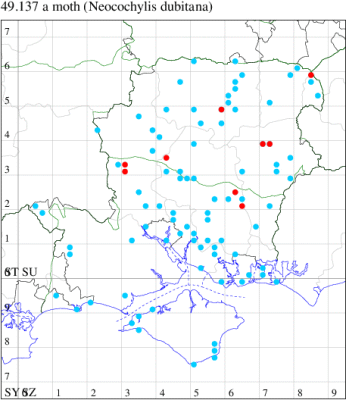
Records by year
Records by week (adult)
Records by week (larval)
Record Details
VC11: Broughton, one, 15 Aug; one, 25 Jul; one, 15 Aug; one, 25 Jul; two, 15 Aug; one, 25 Jul; one, 15 Aug (GCE); West Meon, one, 03 Sep; Old Winchester Hill, one, 11 Jun (RJD, MLO, DWal, KJW det. RJD);
VC12: Crawley, one, 25 Aug (GCE); Kempshott, one, 10 Aug (GAH); Alton, one, 18 Jul; one, 20 Jul (DBO); one, 12 Jul (NDP); Blackwater, one, 29 Jun; one, 14 Aug (BDal)
49.138 [B&F: 0964a] Neocochylis molliculana Zeller, 1847 - Local
Local on rough ground in southern England. First recorded in Britain at Portland in 1993, this species has rapidly colonised the south coast of England. Frequent in Hampshire in the south-east corner of the county, but very rare inland. On the Isle of Wight first appeared in Parkhurst Forest in 2006 since when reported at several sites on the Island. Larva feeds within seedheads of Bristly Oxtongue.
Records prior to 2021
| Vice County | #Records | #Individuals | First Record | Last Record |
|---|---|---|---|---|
| 10 | 74 | 103 | 2006 | 2020 |
| 11 | 963 | 1951 | 1993 | 2020 |
| 12 | 25 | 30 | 1996 | 2020 |
2021 records
| Vice County | #Records | #Individuals | Max Quantity |
|---|---|---|---|
| 10 | 26 | 38 | 5 |
| 11 | 49 | 64 | 5 |
| 12 | 15 | 31 | 8 |
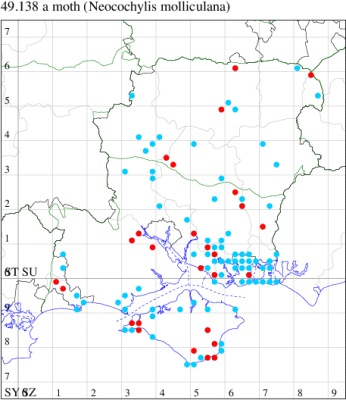
Records by year
Records by week (adult)
Records by week (larval)
Record Details
VC10: Totland, one, 24 Jun; two, 26 Jun; one, 28 Aug; one, 01 Sep (RTer); Freshwater, one, 09 Jun; one, 14 Aug; one, 25 Aug; one, 31 Aug; two, 03 Sep; one, 09 Sep (DCoo); Freshwater Bay, one, 29 Jun (SDav); Freshwater, two, 29 Jun; four, 08 Jul; one, 08 Jul (PBar); Wydcombe, one, 08 Jul (IOut); Rew Down, Ventnor, one, 11 Jul; one, 11 Jul (PBar); Wheelers Bay, one, 11 Jul; one, 24 Aug; five, 06 Sep (ABut); Haseley Manor, one, 13 Jul; Shanklin, one, field observation, 16 Jun; one, 23 Jun; one, field observation, 02 Jul; two, 14 Jul; two, 06 Oct (IOut);
VC11: Marchwood, one, 12 Jun (CTha); Woodlands, NF, present, 08 Sep (RBW); Totton, one, 25 Aug (LHan); Titchfield Haven NNR, three, 25 Jun (RJD, DWal, KJW, RCar, DHun); Botley Wood, one, 13 Aug (MLO, ADT, DWal, KJW); one, 10 Sep (RJD, MLO, DWal, KJW det. RJD); Lee-on-Solent, one, 19 Aug; one, 28 Aug; one, 31 Aug; one, 01 Sep (IHrg); Fareham, one, 14 Aug; one, 05 Sep; one, 14 Sep (MLO); Botley, one, 20 Aug; one, 21 Aug (SLB); Portsmouth, one, 05 Jun; one, 08 Jun; one, 09 Jun; one, 10 Jun; two, 11 Jun; one, 12 Jun; five, 14 Jun; three, 16 Jun; one, 30 Jun; two, 01 Jul; one, 02 Jul; two, 03 Jul; one, 04 Jul; one, 13 Jul; one, 15 Jul; one, 16 Jul; one, 18 Jul; one, 19 Jul; one, 20 Jul; two, 11 Aug; one, 14 Aug; one, 19 Aug; five, 20 Aug; two, 03 Sep; one, 06 Sep; one, 07 Sep; one, 21 Sep (IRT); West Meon, one, 02 Jul (RJD, MLO, ADT, DWal, KJW); Old Winchester Hill, one, 11 Jun (RJD); Horndean, one, 20 Aug; one, 10 Sep; one, 20 Aug (PHog); Merritown Heath, present, 10 Jun (DFoo); Hurn, one, 02 Jul (MJef);
VC12: Crawley*, two, 25 Aug; one, 25 Aug; one, 14 Jun (GCE); Kempshott, one, 22 Aug (GAH); Pamber Forest*, one, 11 Jun; four, 16 Jun; eight, 24 Jun; two, 28 Jun; two, 05 Jul; three, 16 Jul; two, 04 Sep; one, 08 Sep (GJD); Blackwater, one, 26 Jun; one, 25 Aug; one, 06 Sep (BDal)
49.139 [B&F: 0966] Cochylichroa atricapitana (Stephens, 1852) - Common
Common on chalk downland and rough ground throughout the British Isles. In Hampshire and on the Isle of Wight widespread and fairly common on chalk downland and along the coast, and increasingly common wherever the larval foodplant is allowed to prosper. Wingspan 12-16 mm. The dark coloration of the head and thorax distinguish this species from C. dubitana and C. hybridella [Bradley]. Larva feeds on the flowers, stems and roots of Common Ragwort, over-wintering in a cocoon.
Records prior to 2021
| Vice County | #Records | #Individuals | First Record | Last Record |
|---|---|---|---|---|
| 10 | 299 | 411 | 1850 | 2020 |
| 11 | 1797 | 2297 | 1972 | 2020 |
| 12 | 406 | 492 | 1993 | 2020 |
2021 records
| Vice County | #Records | #Individuals | Max Quantity |
|---|---|---|---|
| 10 | 51 | 63 | 4 |
| 11 | 86 | 104 | 5 |
| 12 | 32 | 41 | 3 |
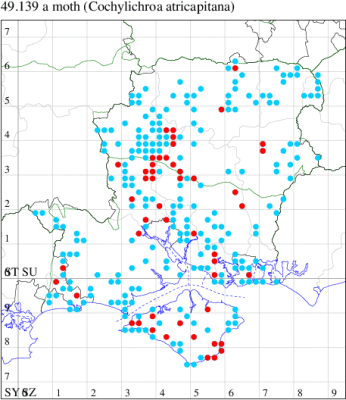
Records by year
Records by week (adult)
Records by week (larval)
Record Summary
VC10: Earliest: Bonchurch, 10 May, 1 (JHa) Latest: Shanklin, 07 Sep, 1 (IOut) Max count: Rookley, 05 Jun, 4 (JRB)
VC11: Earliest: Portsmouth, 09 May, 1 (IRT) Latest: Botley, 09 Sep, 1 (SLB) Max count: Portsmouth, 14 Aug, 5 (IRT)
VC12: Earliest: Little Somborne, 28 May, 1 (GCE) Latest: Barton Stacey, 24 Sep, 1 (GCE) Max count: Barton Stacey, 01 Aug, 3 (GCE)
49.142 [B&F: 0960] Falseuncaria ruficiliana (Haworth, 1811) - Local
Local on downland, heathland and mosses throughout much of the British Isles. In Hampshire mainly restricted to downland sites such as Martin Down and Portsdown in the south, and Noar Hill in the north. On the Isle of Wight, has been recorded in the past, but there has been no recent records. Wingspan 12-15 mm. The lack of rose coloration in the forewing and the comparatively broad whitish-edged median fascia distinguish this species from F. degreyana [Bradley]. Larva feeds within seedheads of Cowslip and Lousewort, over-wintering in a cocoon.
Records prior to 2021
| Vice County | #Records | #Individuals | First Record | Last Record |
|---|---|---|---|---|
| 10 | 2 | 0 | 1856 | 1880 |
| 11 | 20 | 34 | 1966 | 2020 |
| 12 | 20 | 21 | 1950 | 2020 |
2021 records
| Vice County | #Records | #Individuals | Max Quantity |
|---|---|---|---|
| 12 | 3 | 4 | 2 |
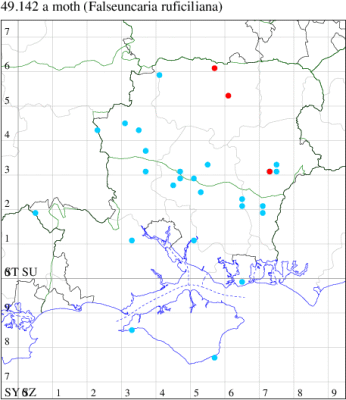
Records by year
Records by week (adult)
Records by week (larval)
Record Details
VC12: Great Haughurst Copse, Axmansford, one, 20 Aug (ACB det. MJW); Basingstoke, one, 27 Aug (MJW); Noar Hill, two, field observation, 01 May (BDal)
()(IMG_5924).jpg)
()(IMG_5908).jpg)

(Larva on Wayfaring-tree)(IMG_5804).jpg)
()IMG_5933).jpg)
()IMG_6015).jpg)